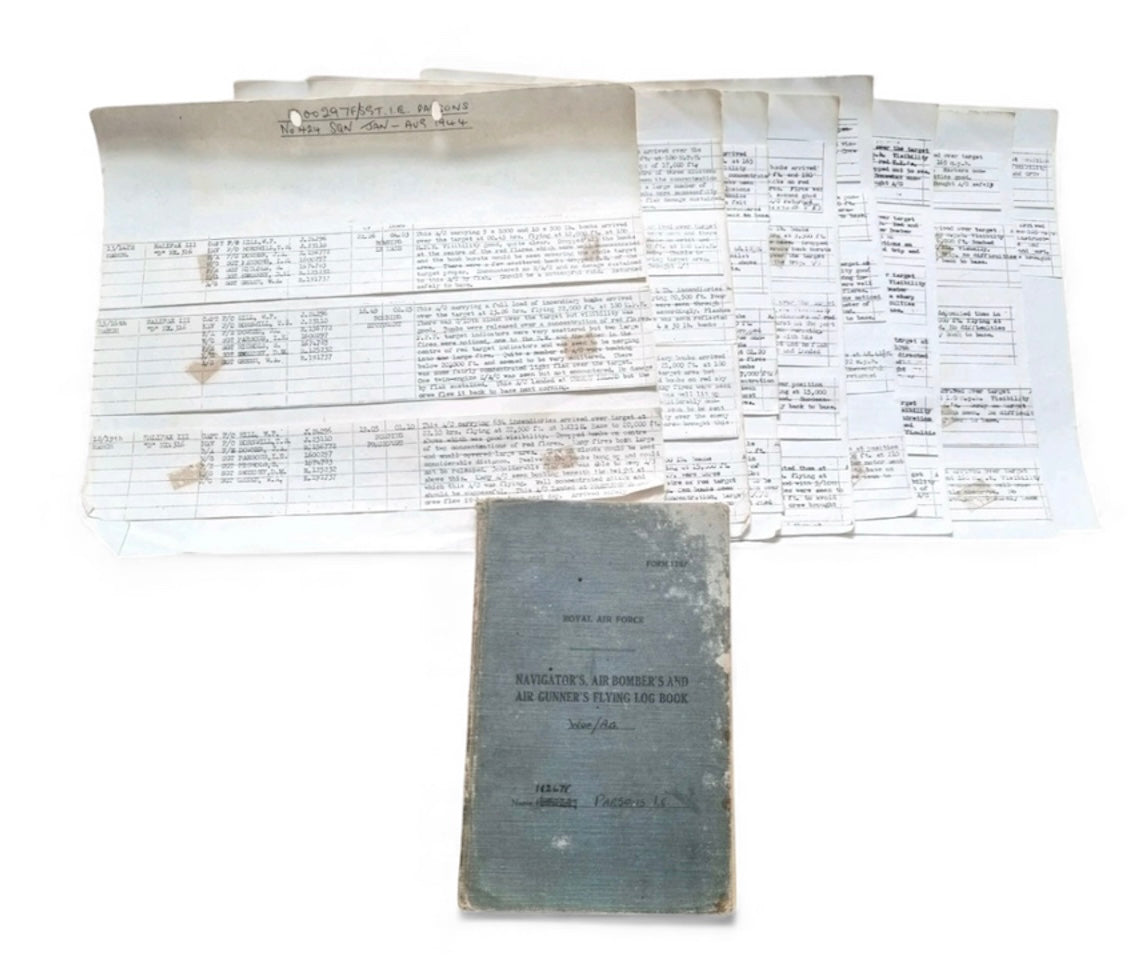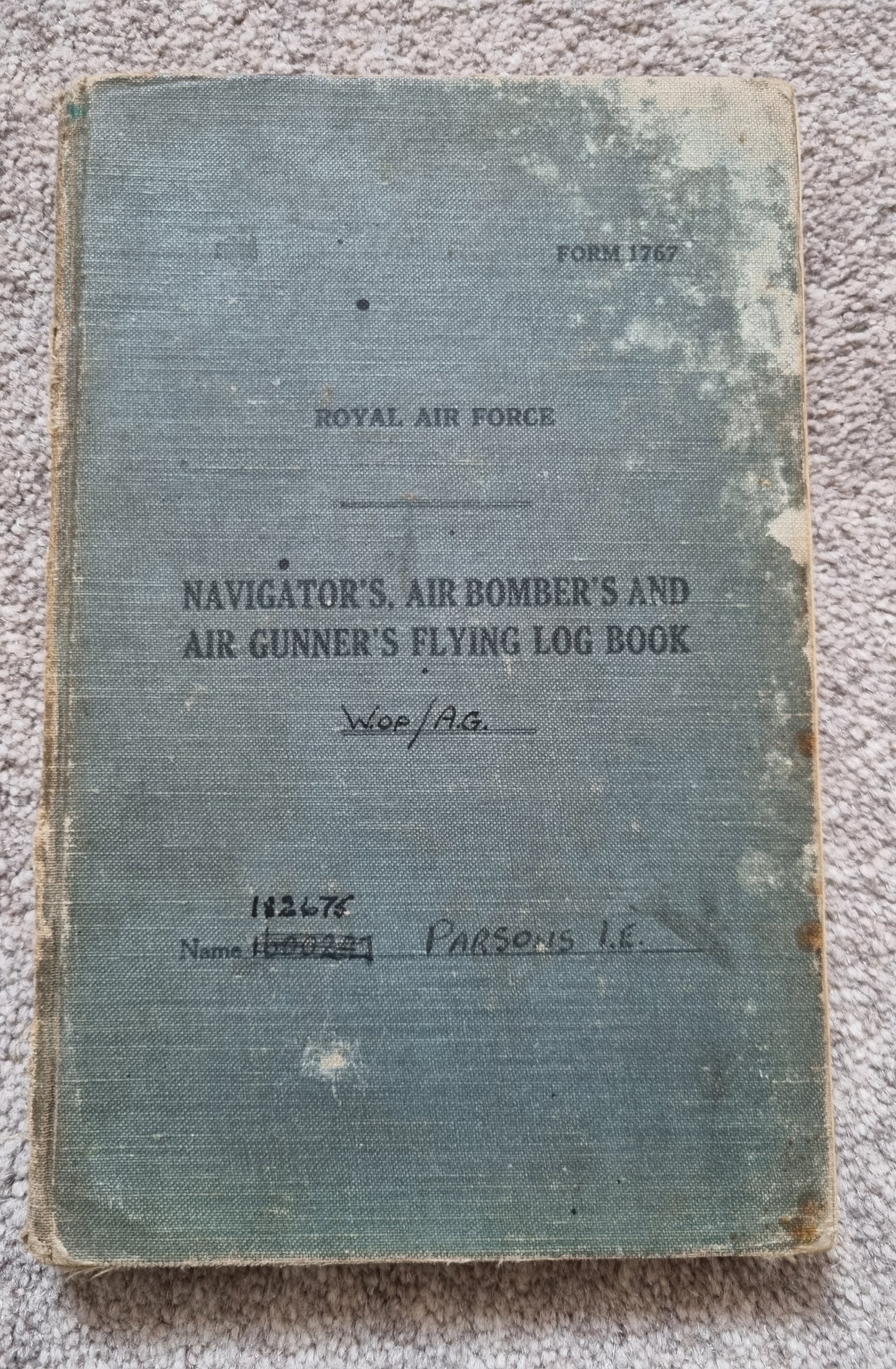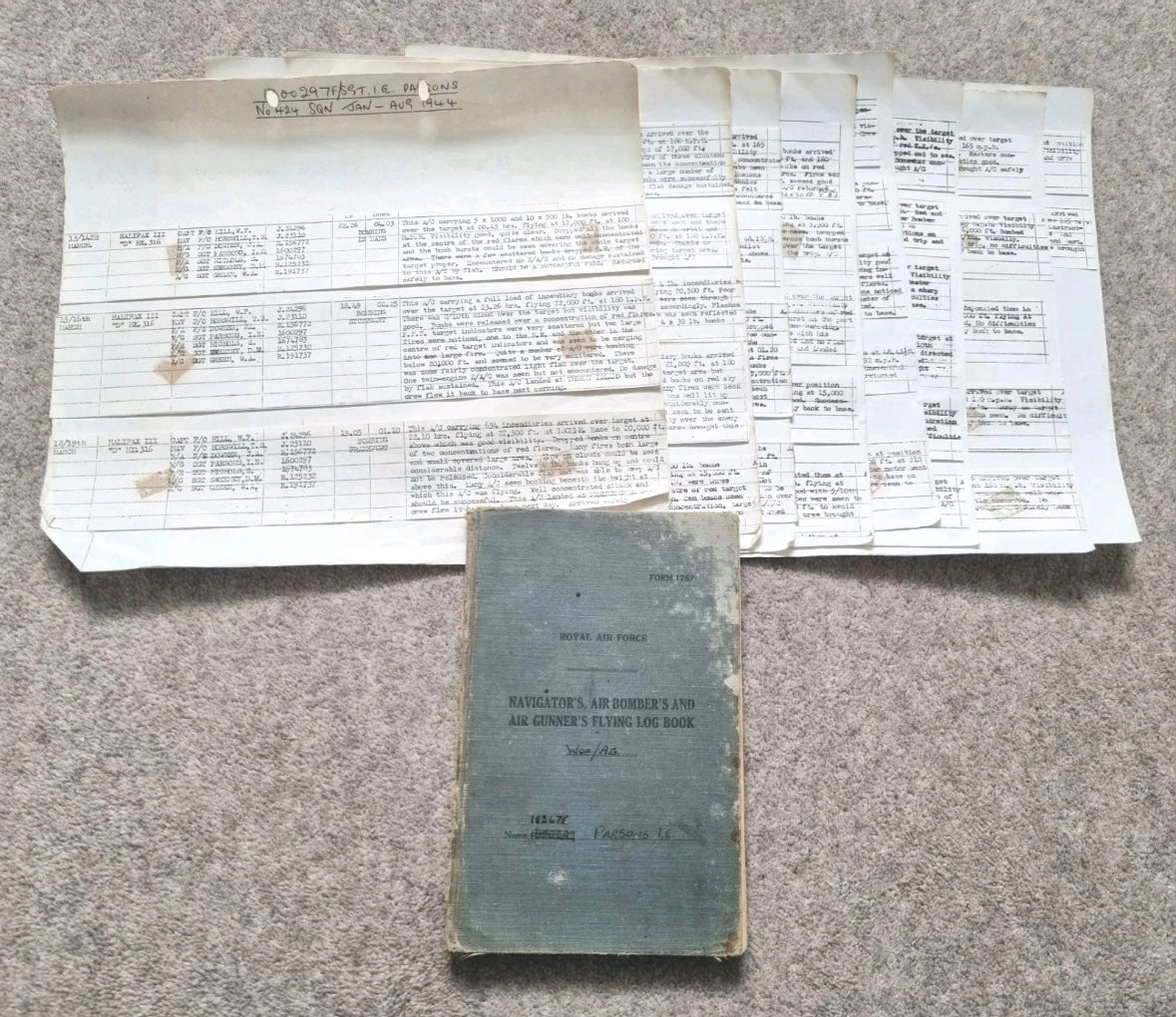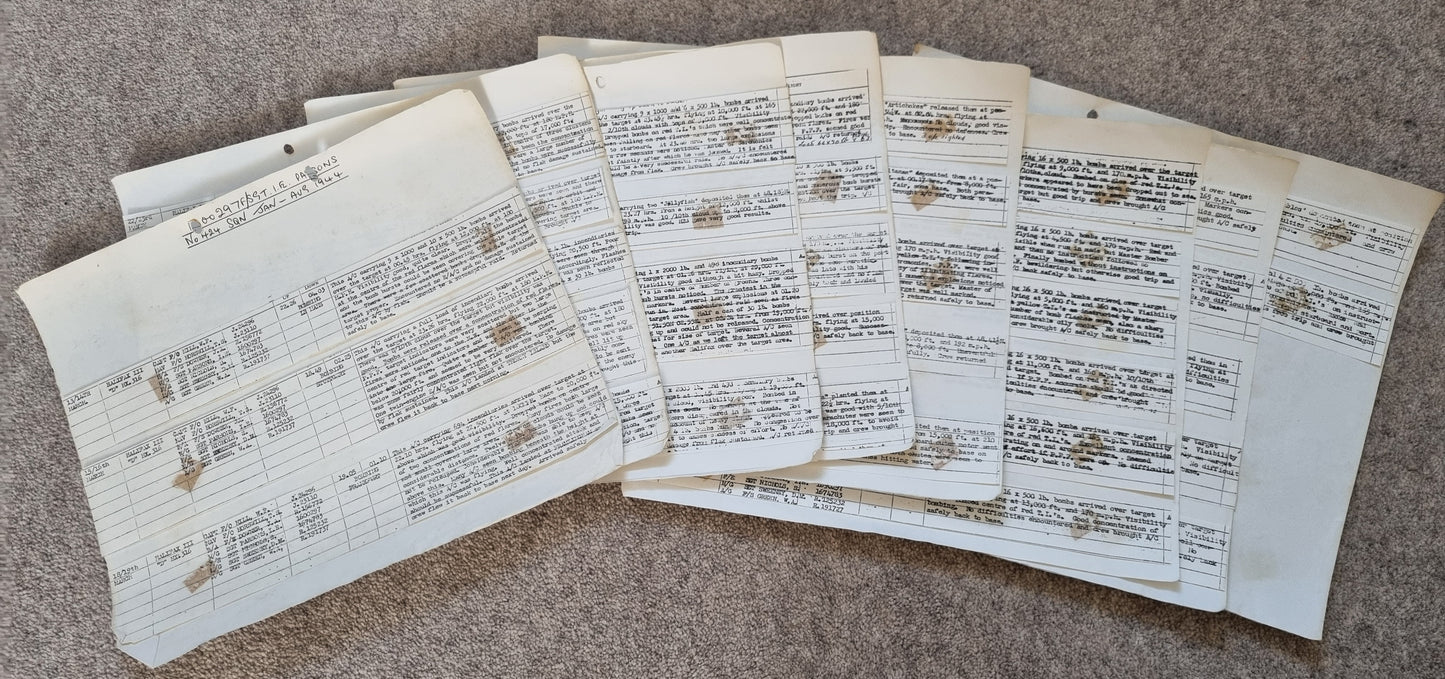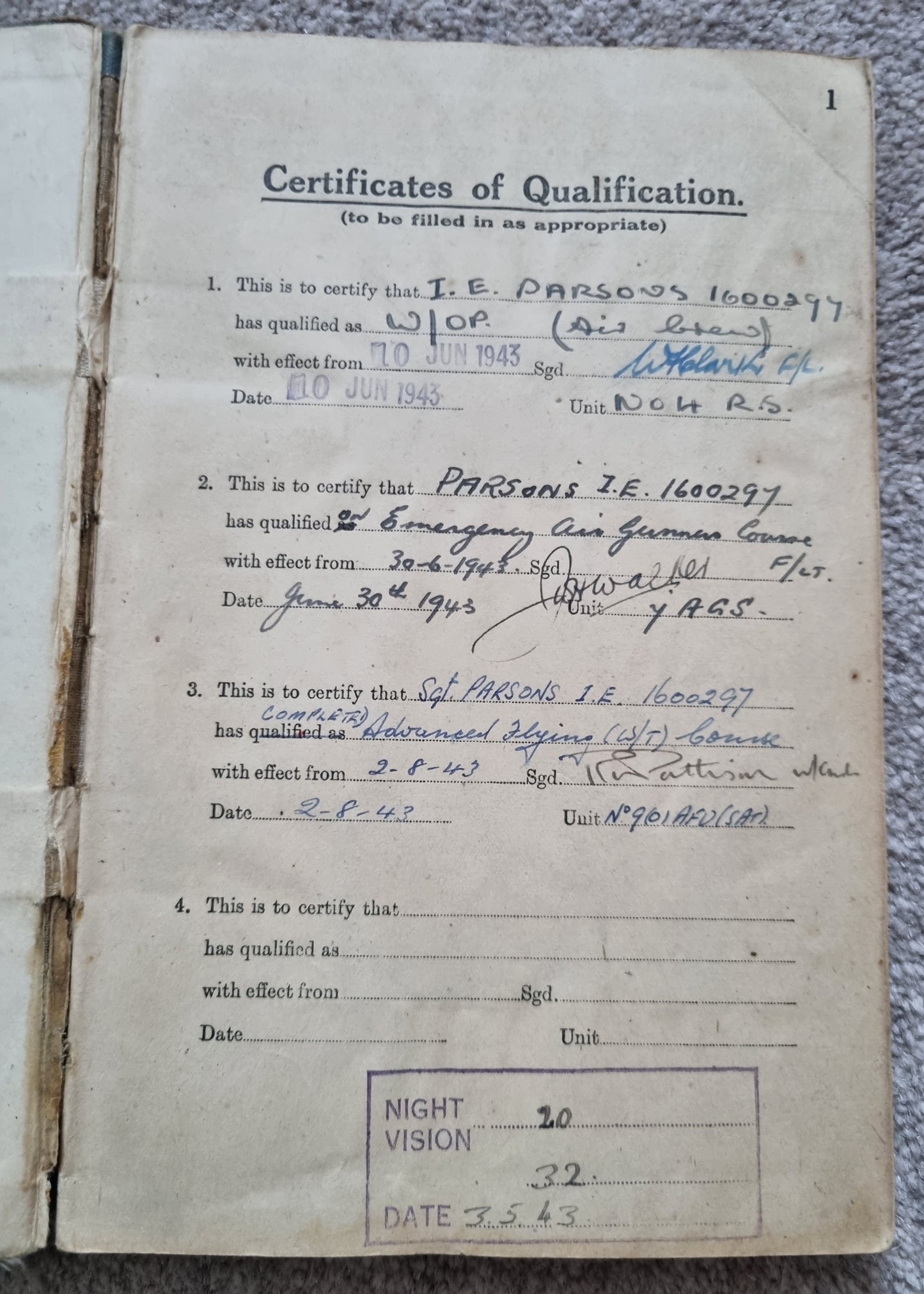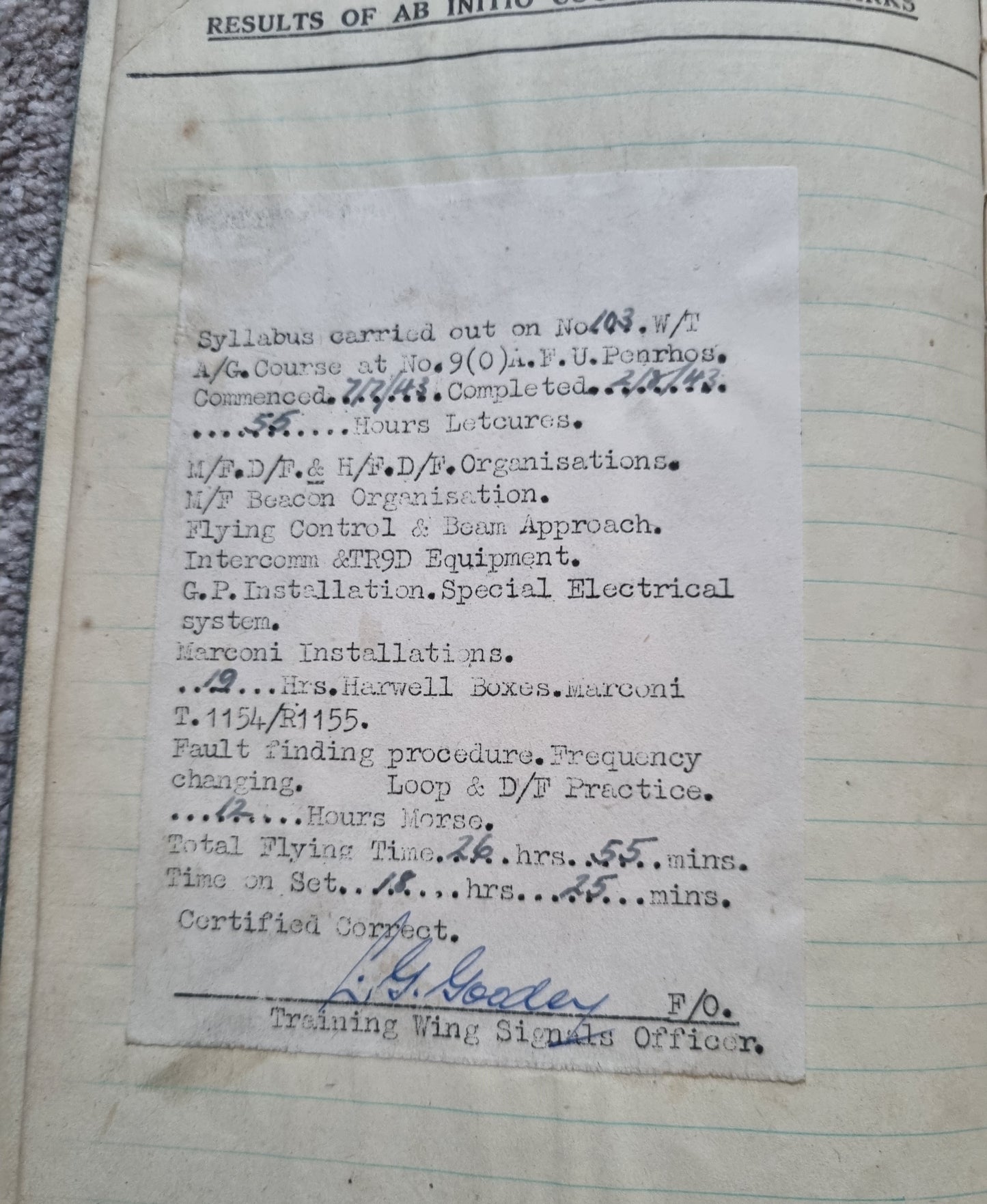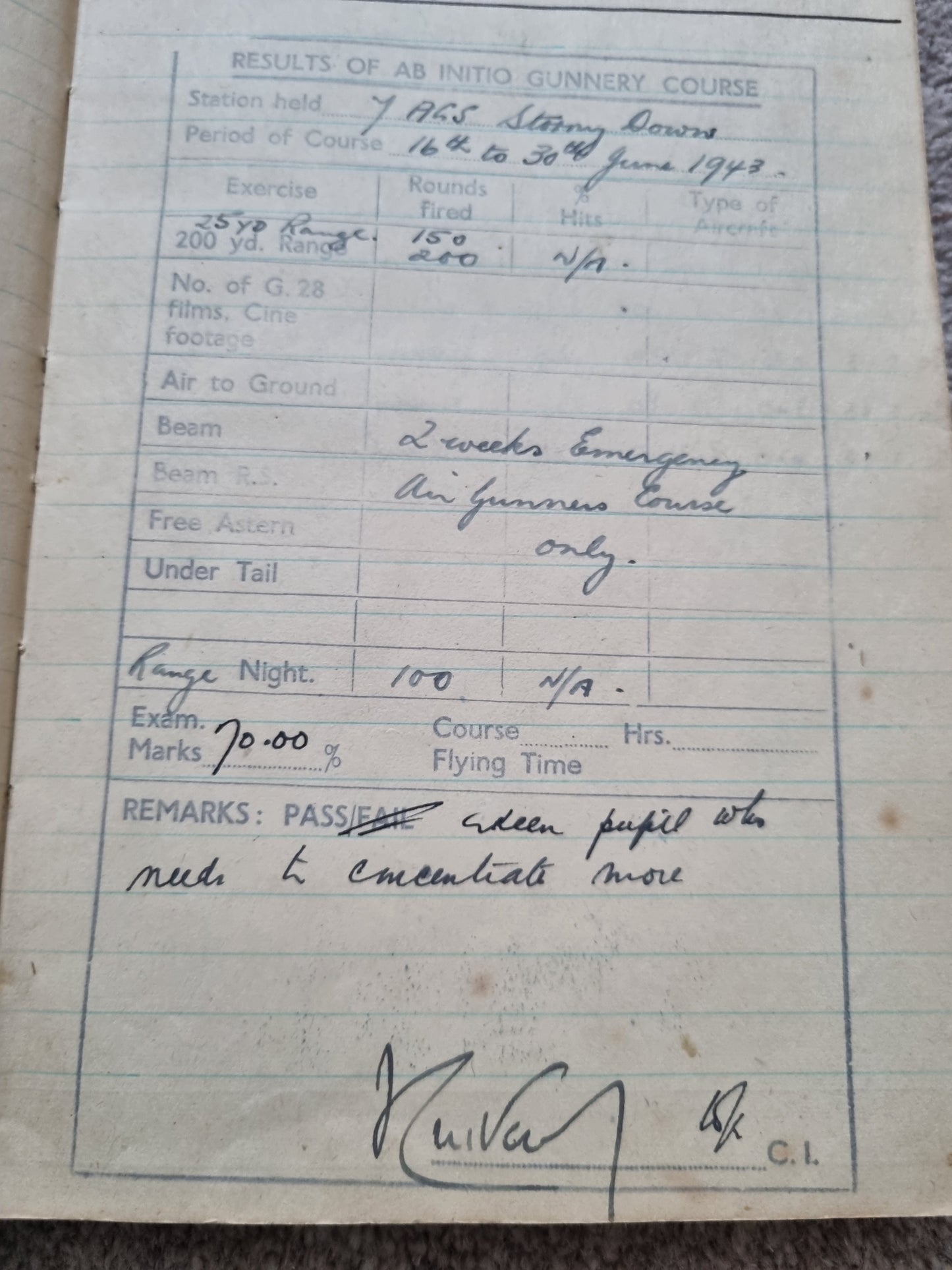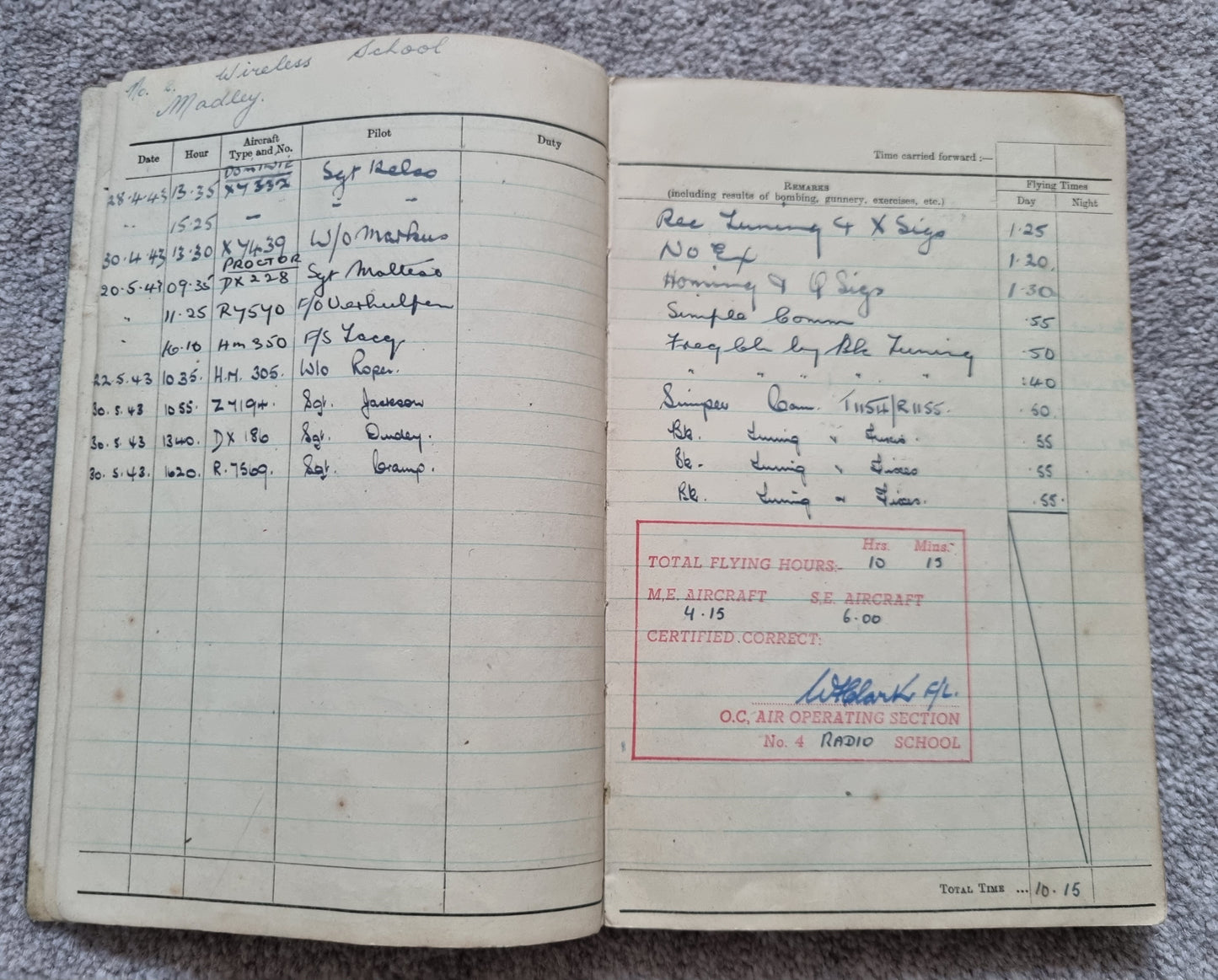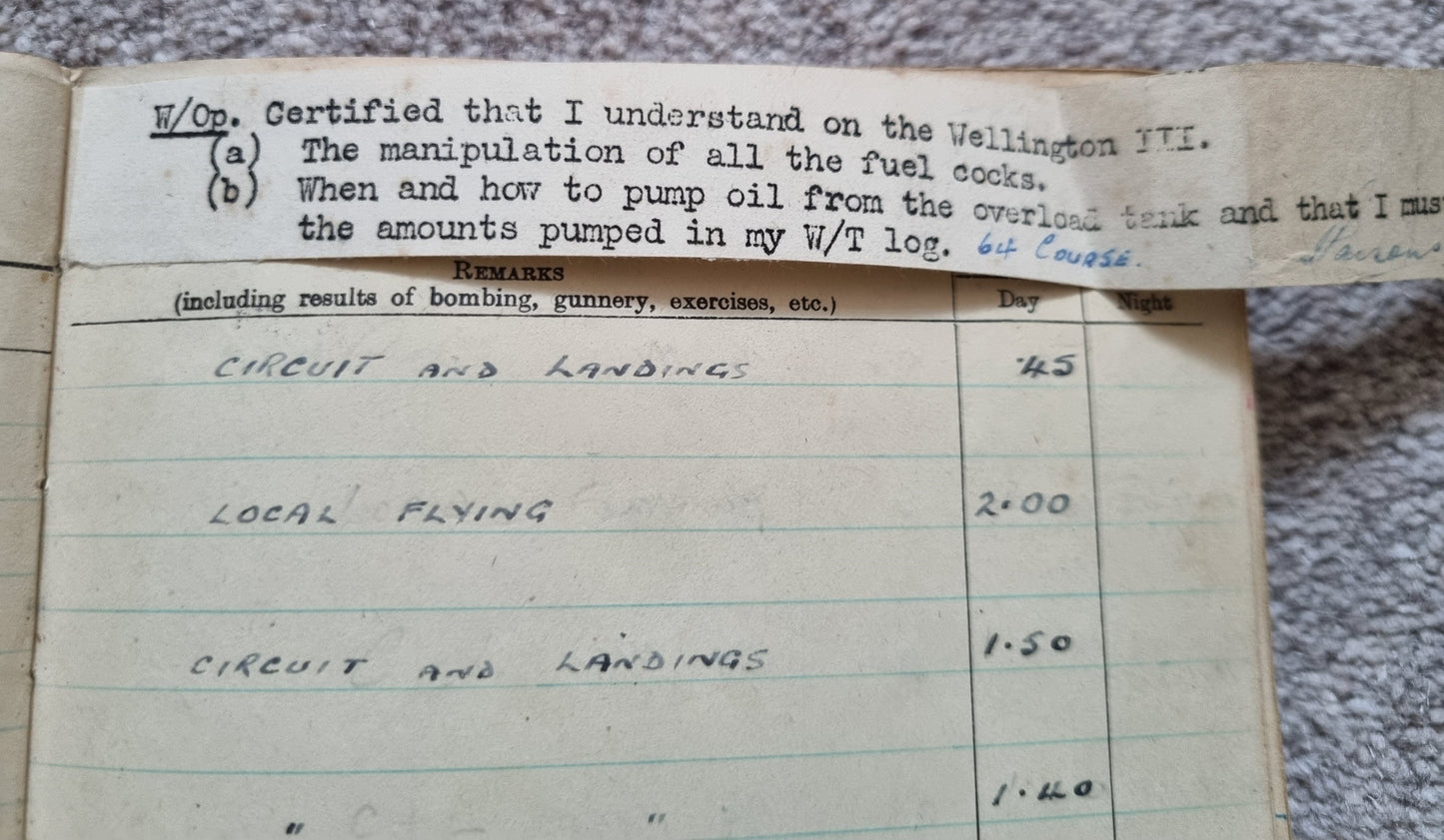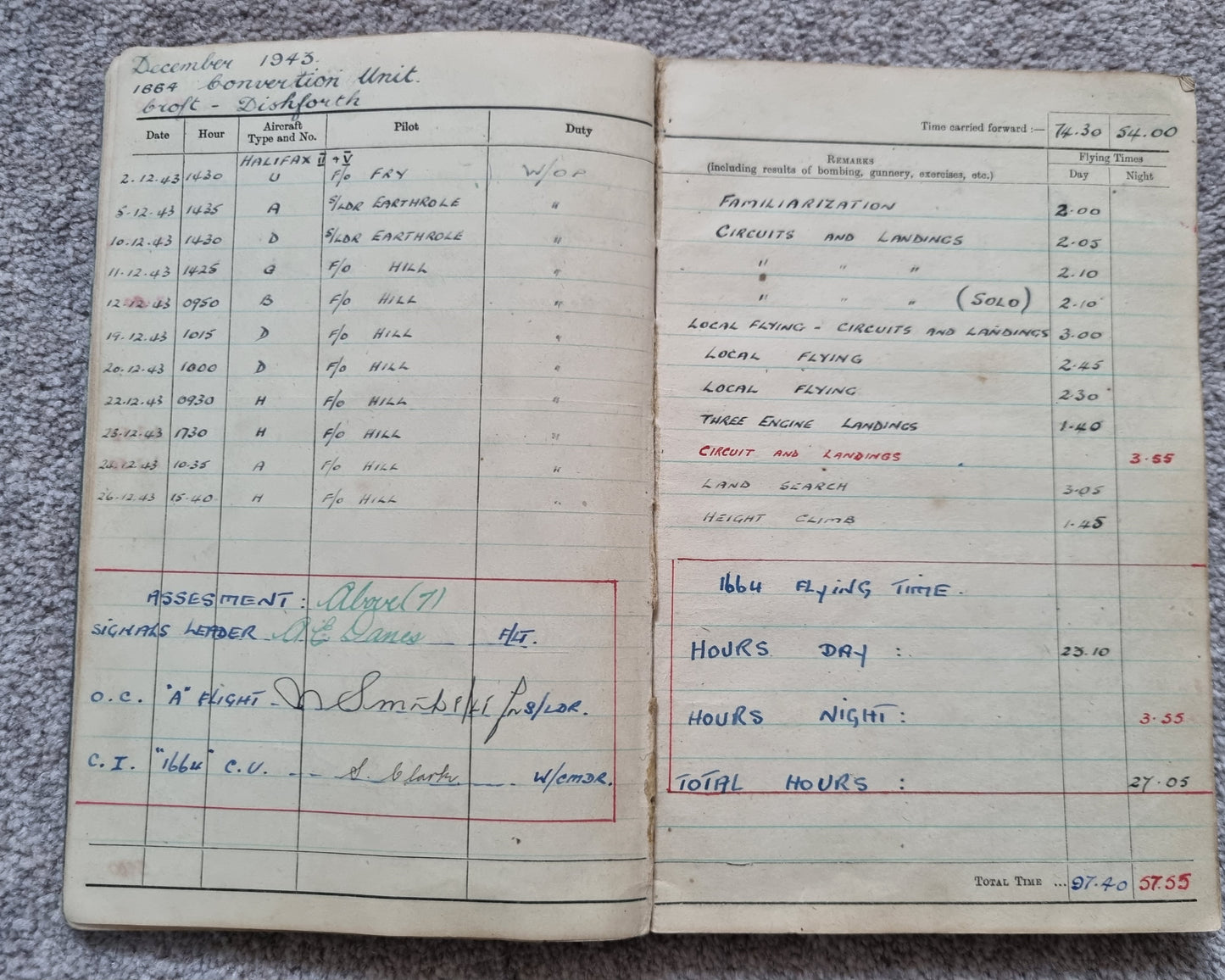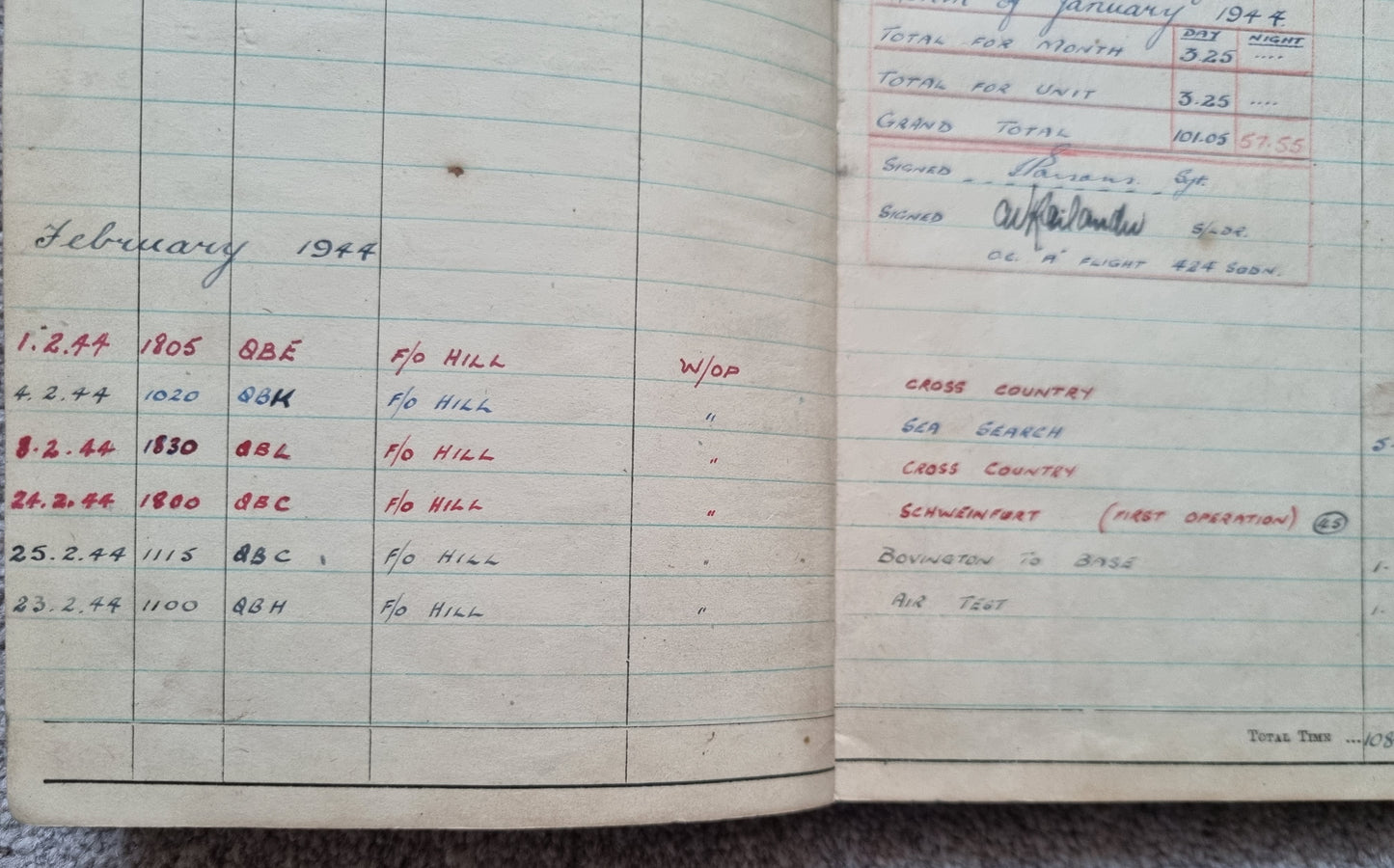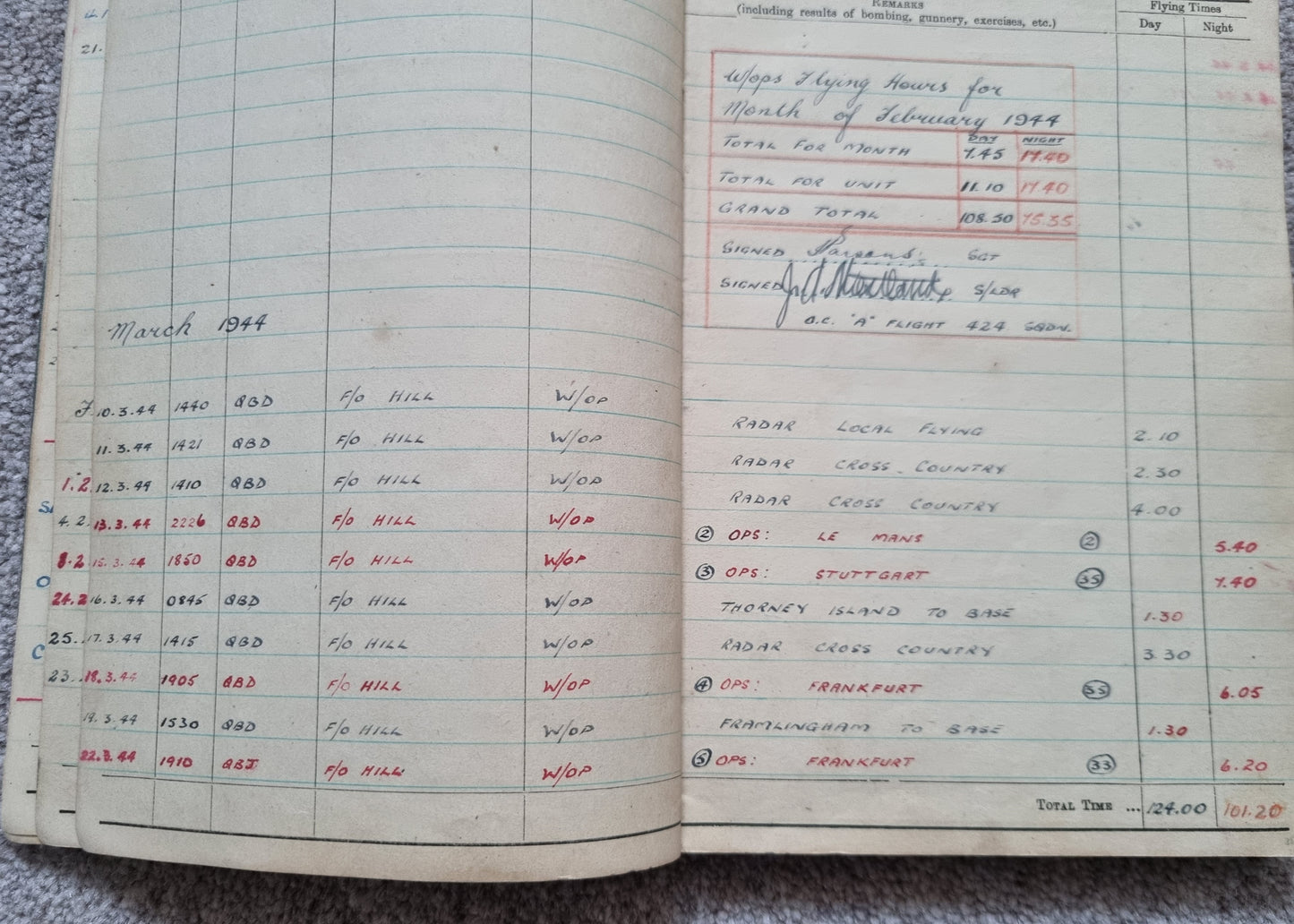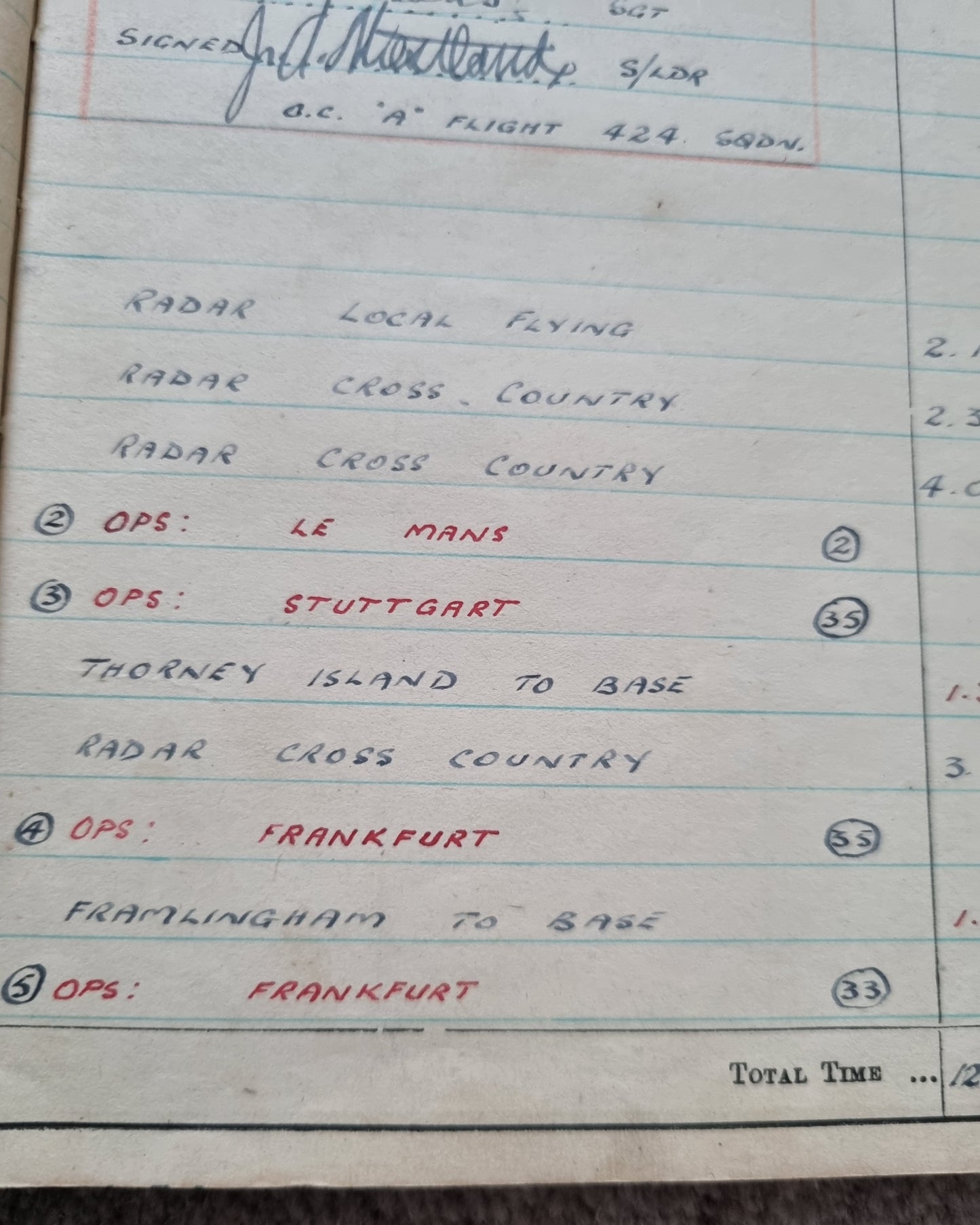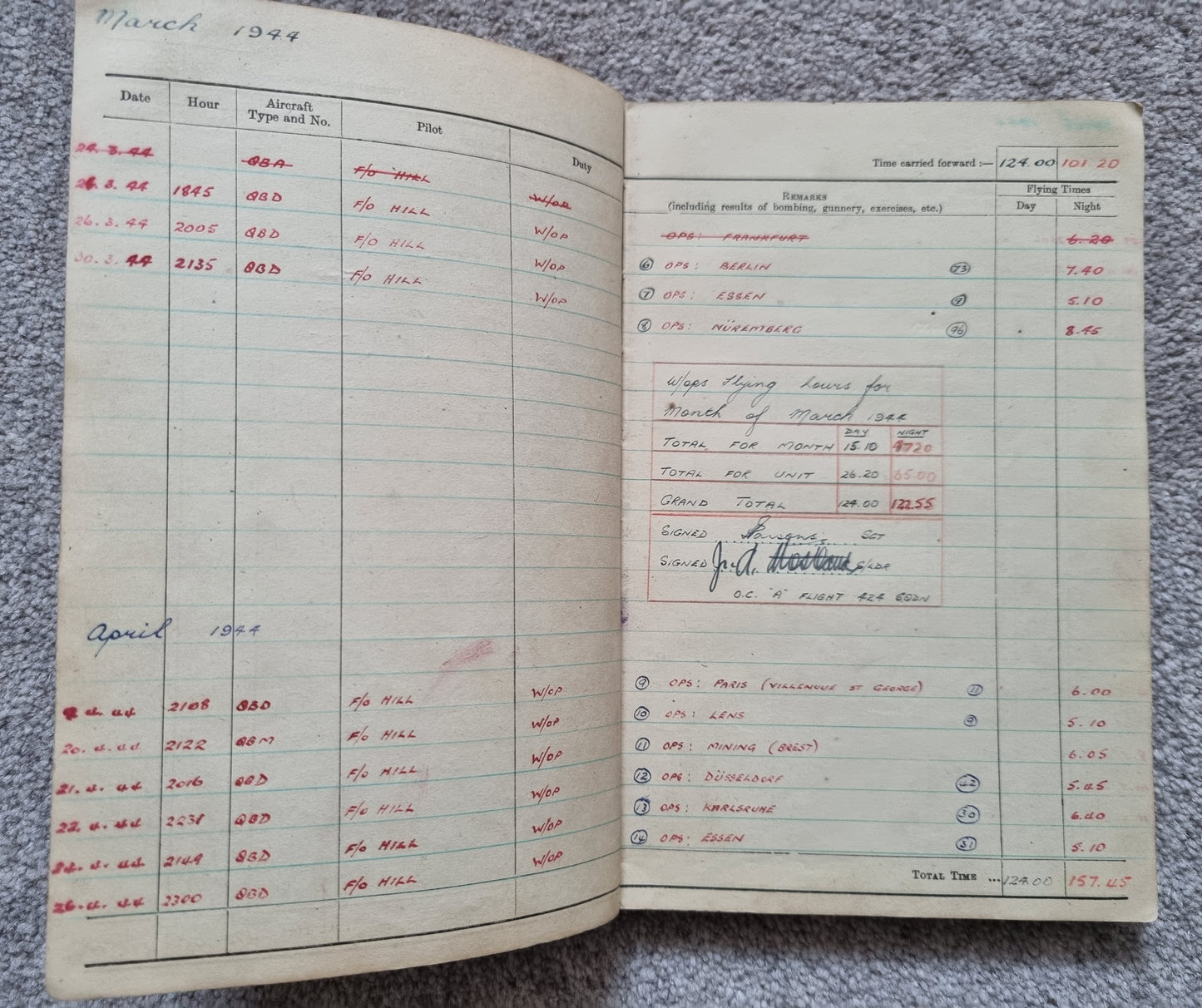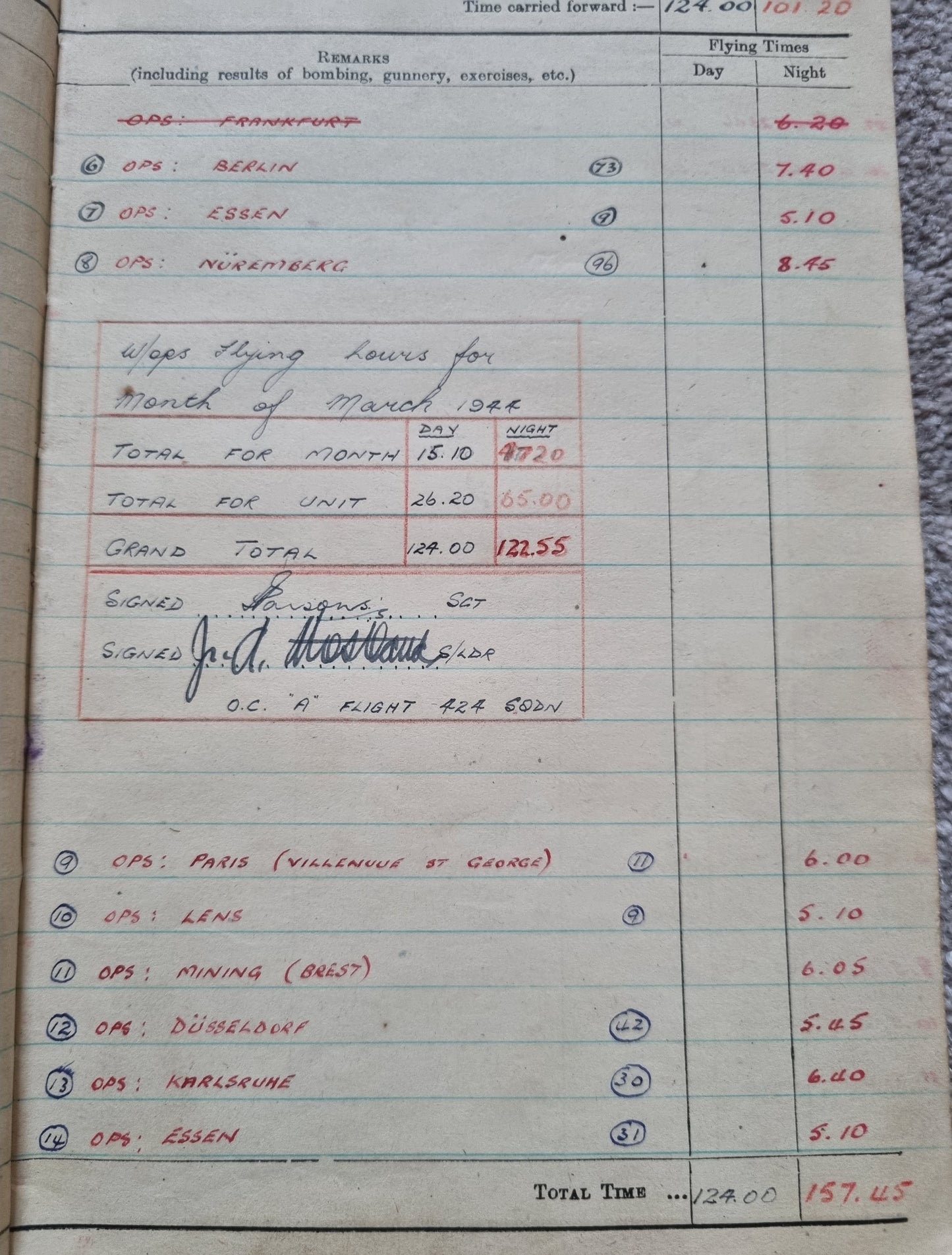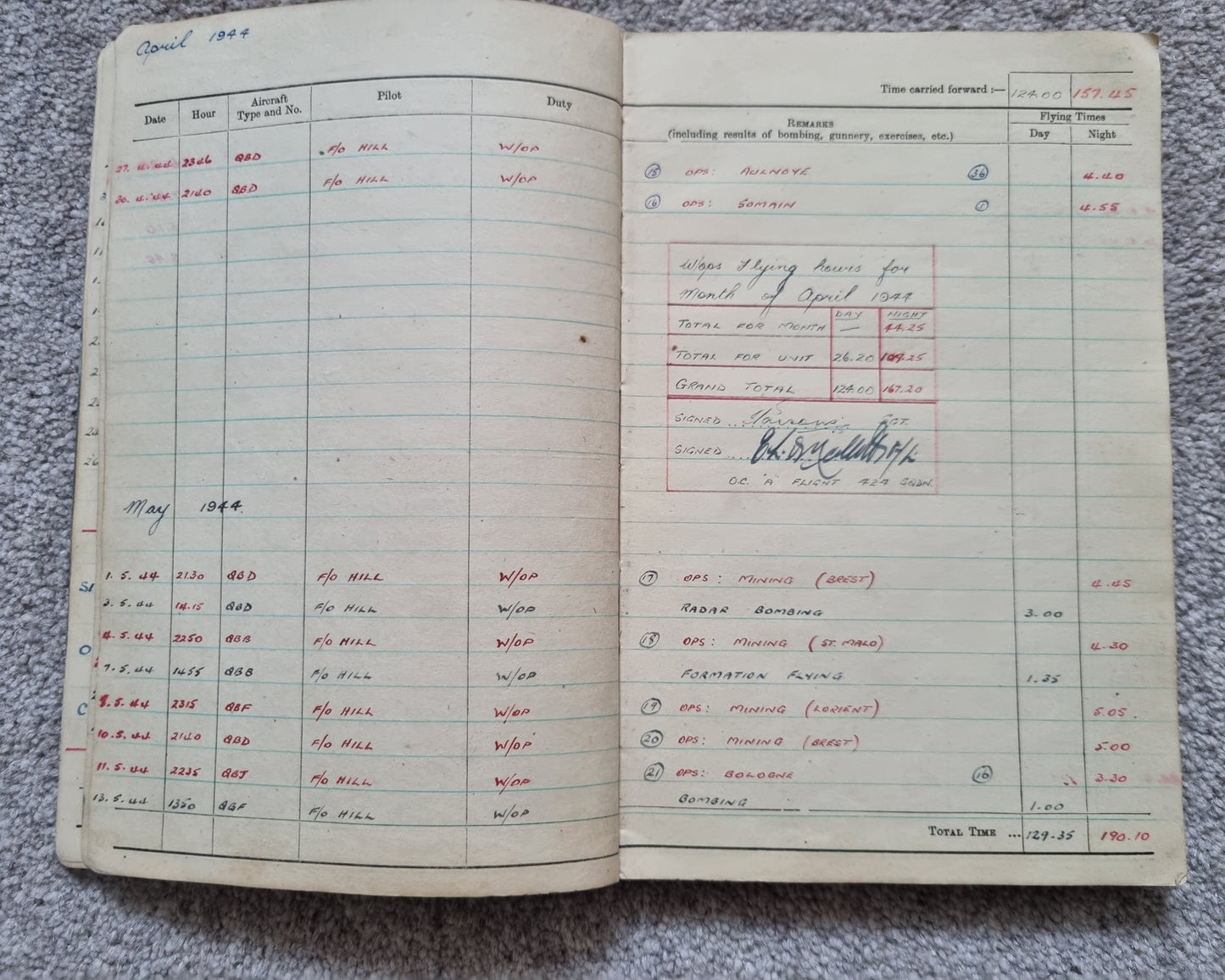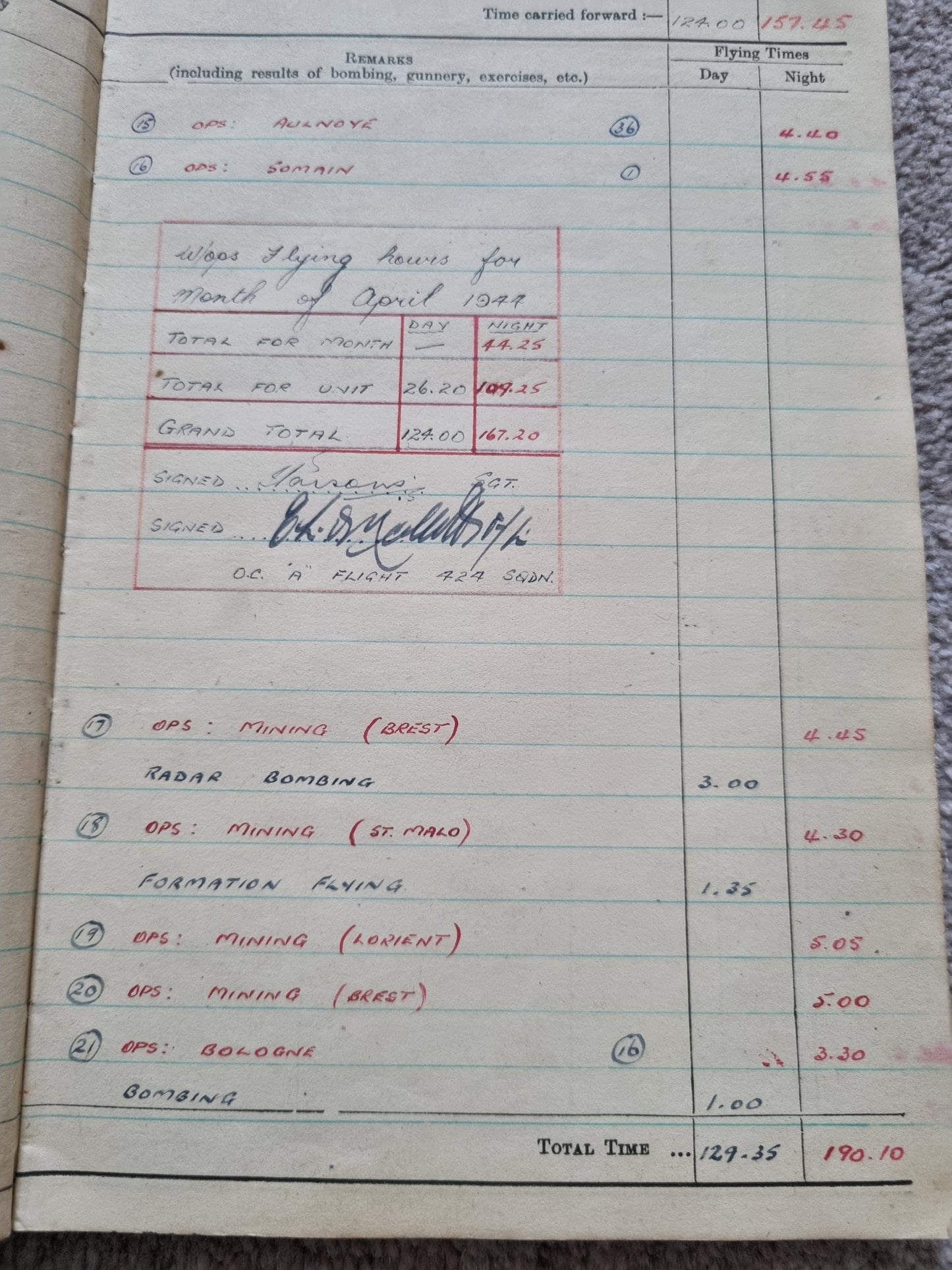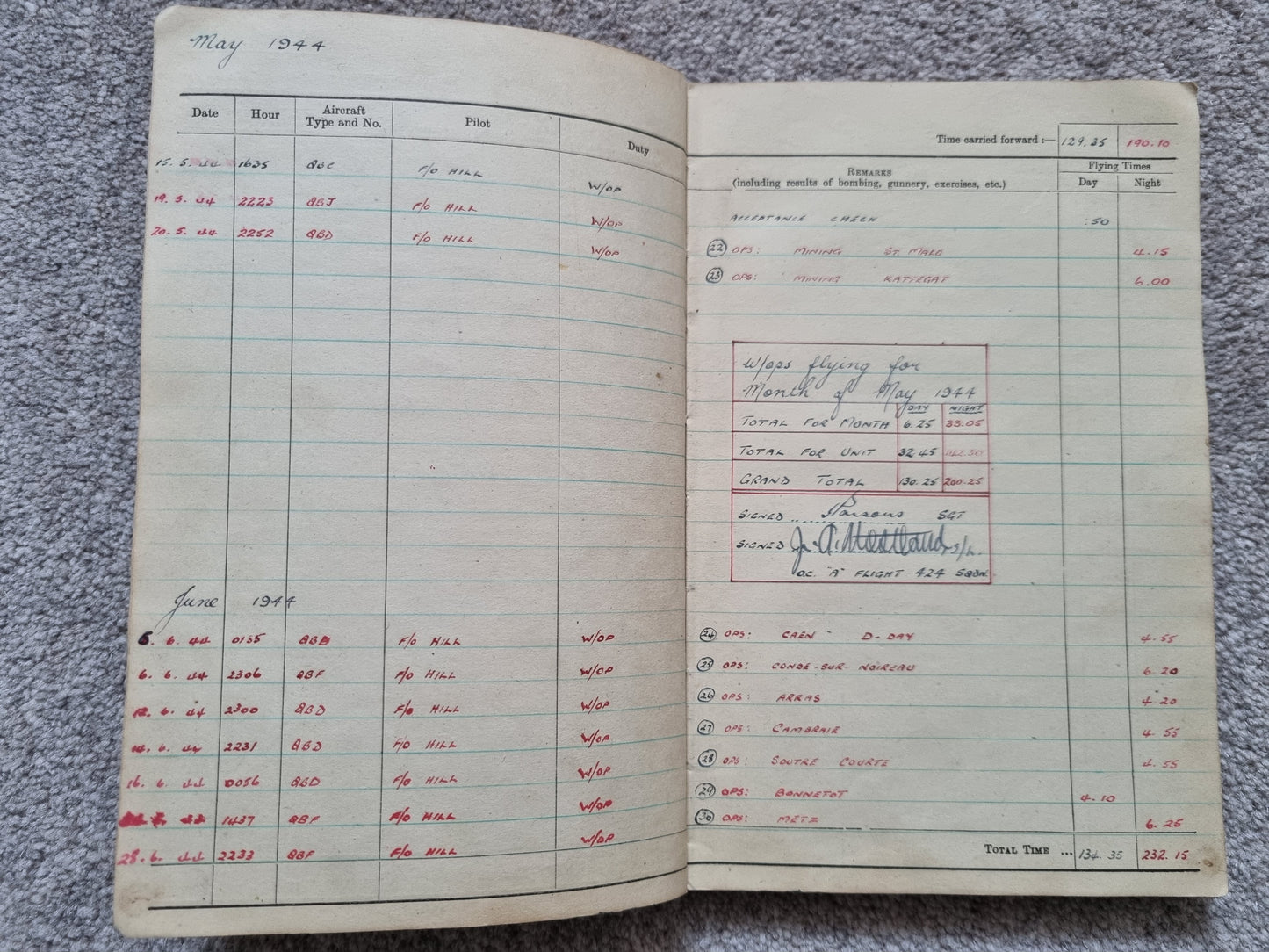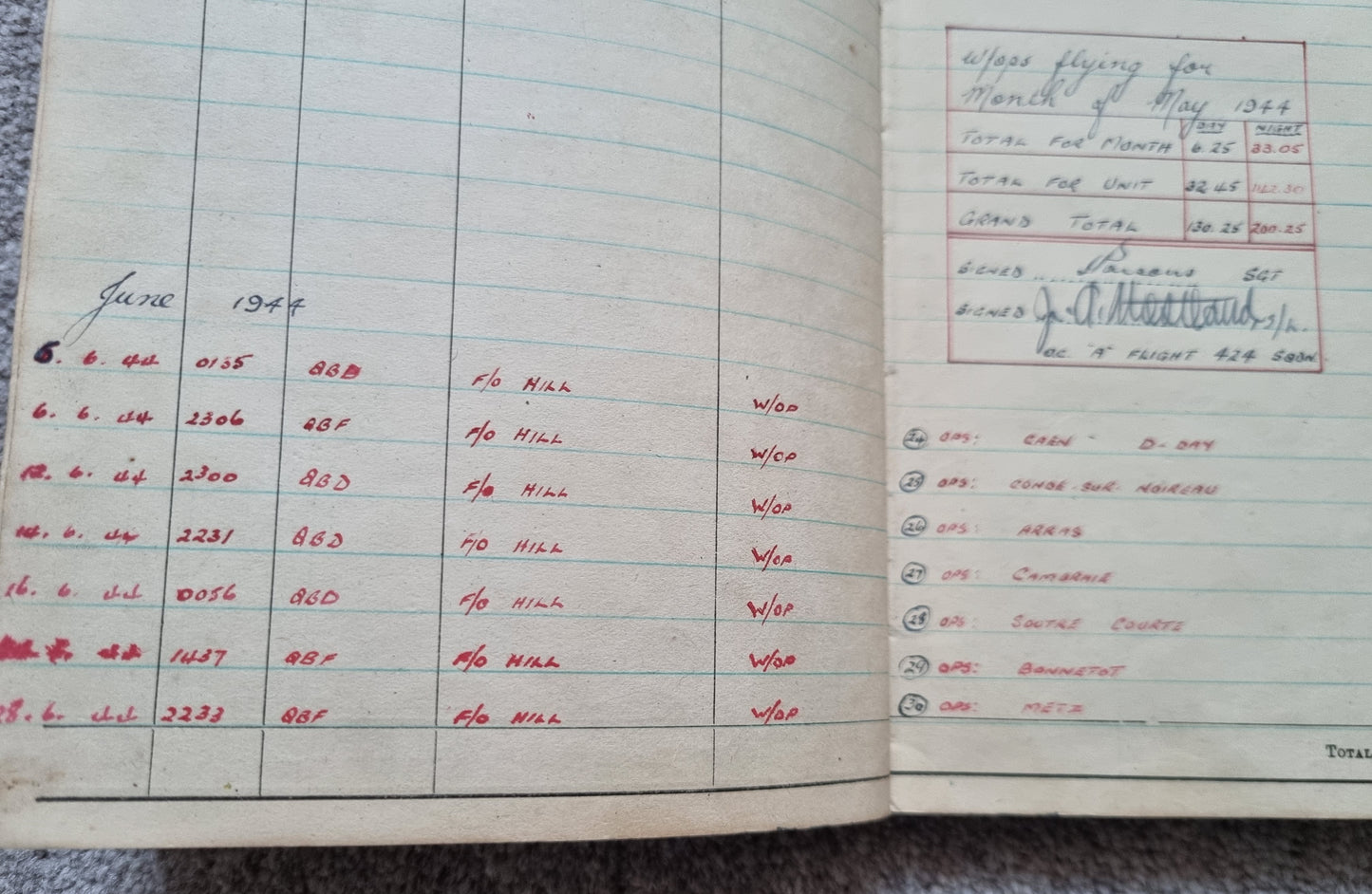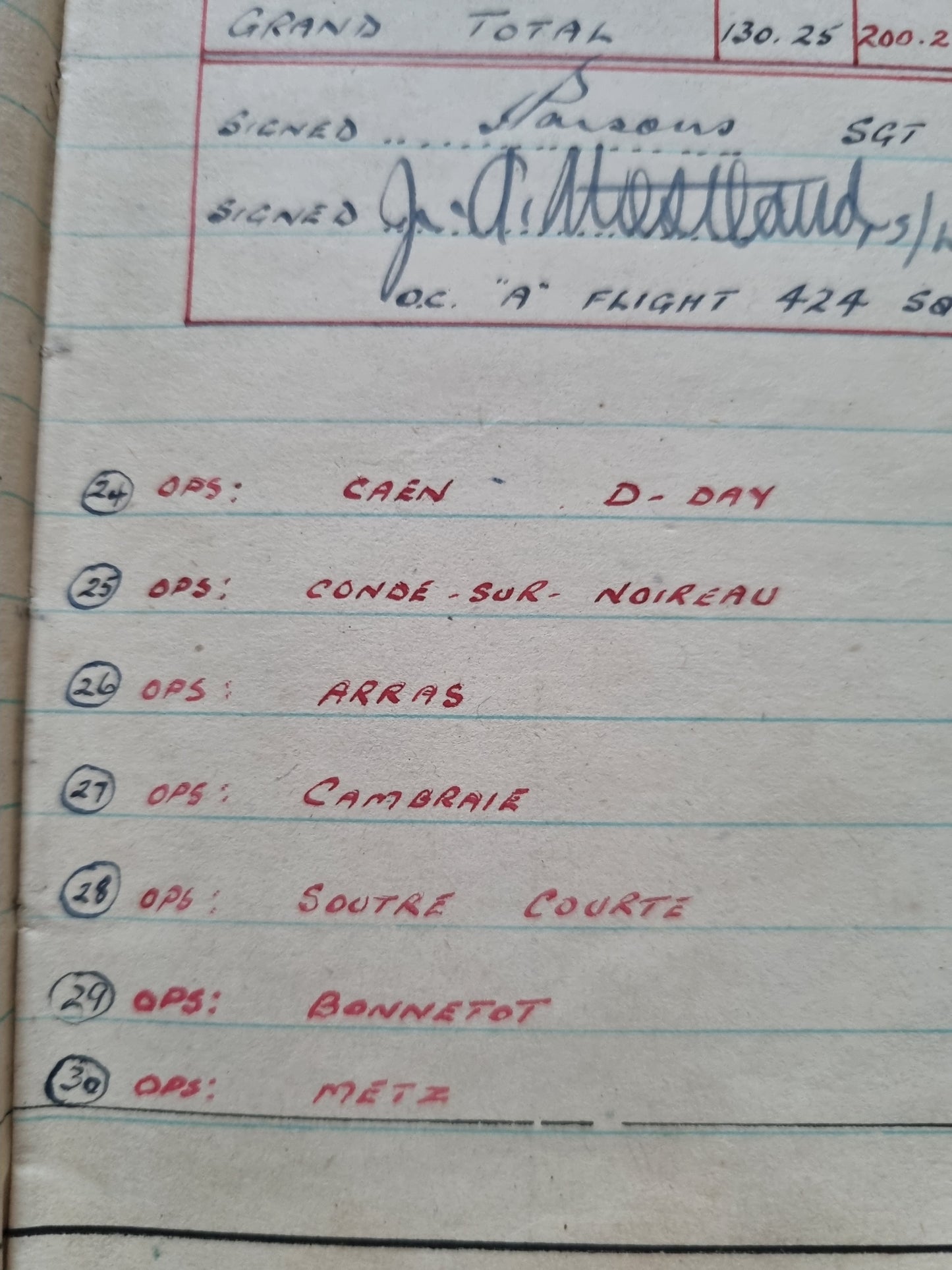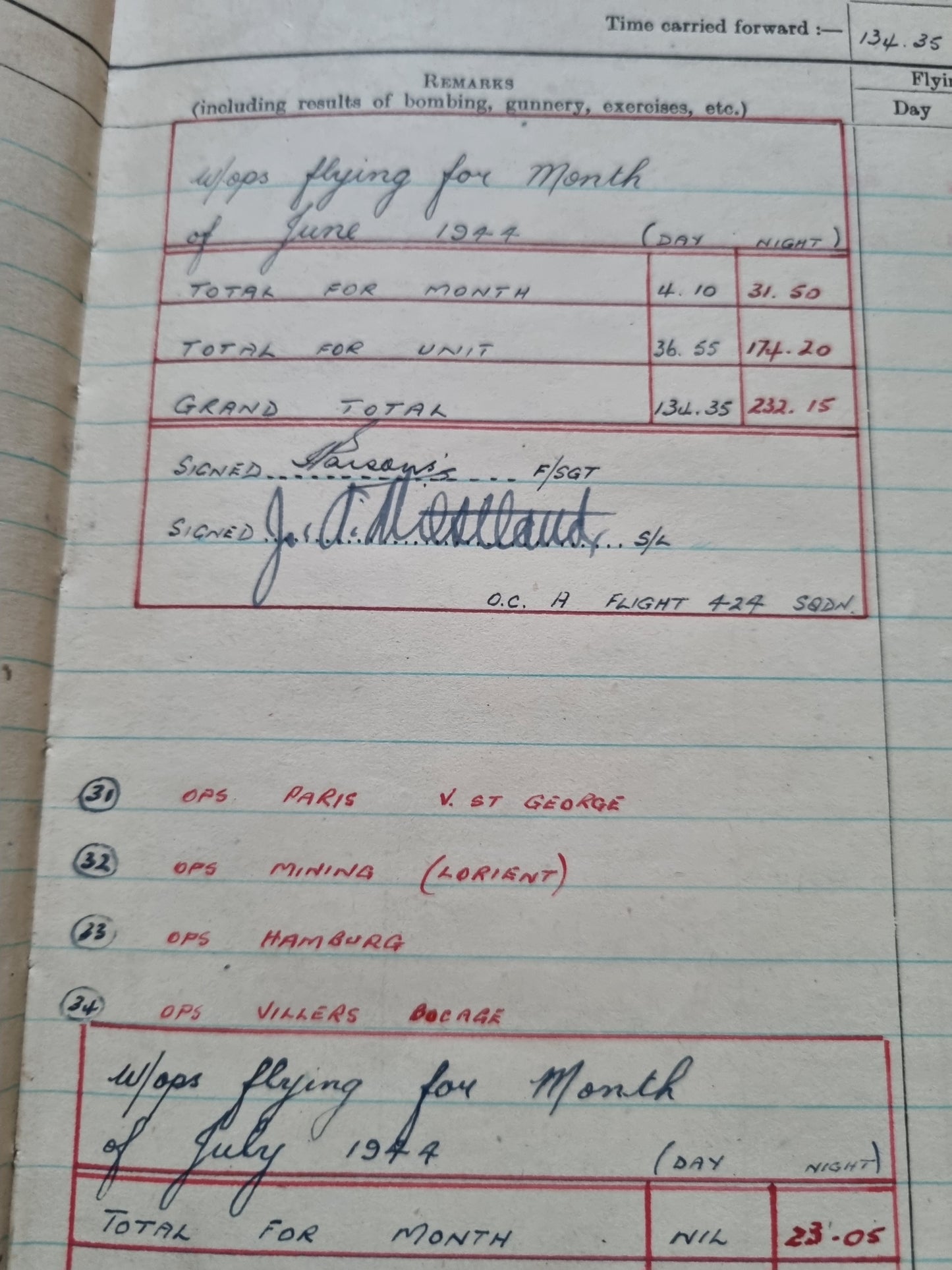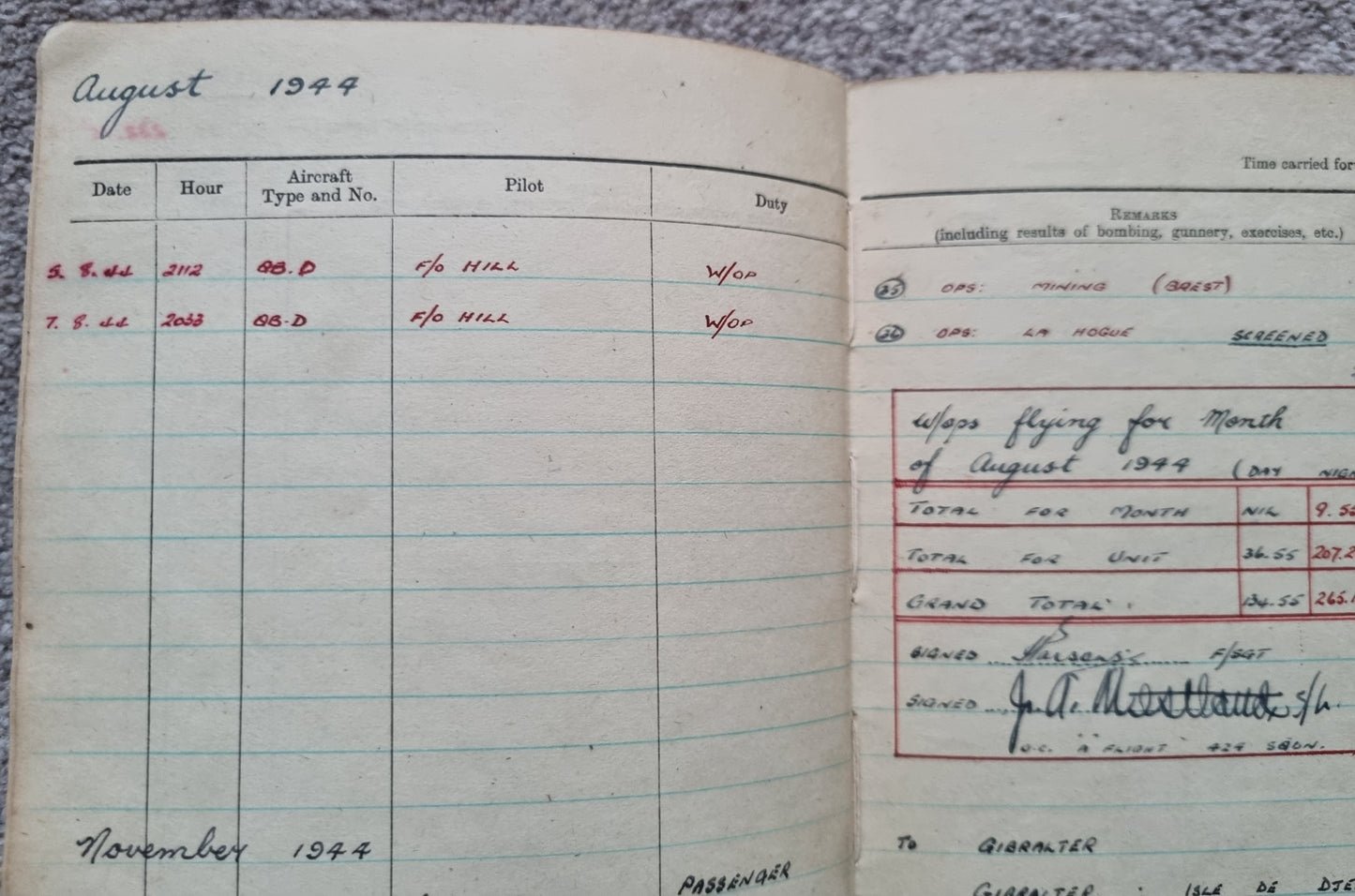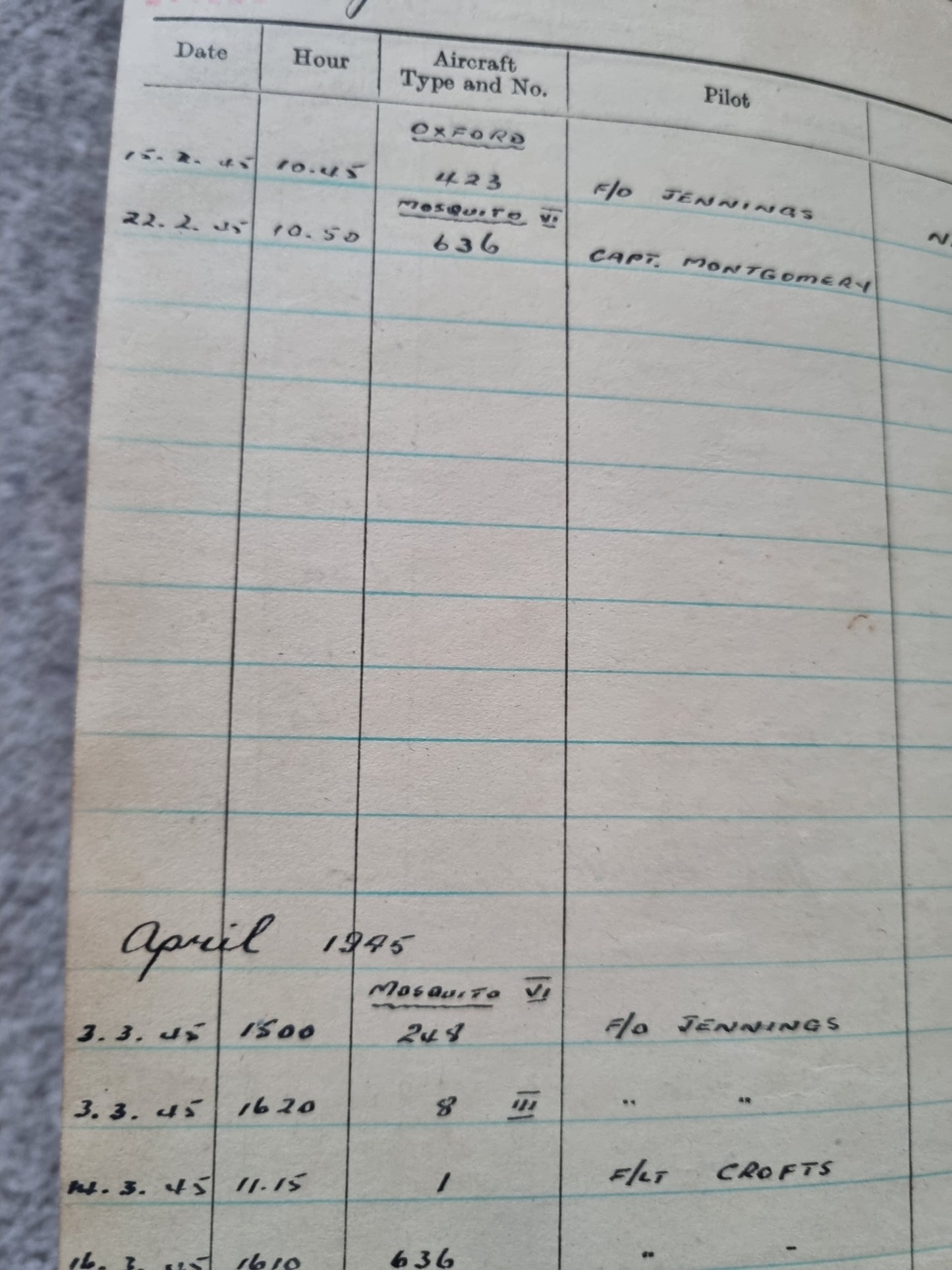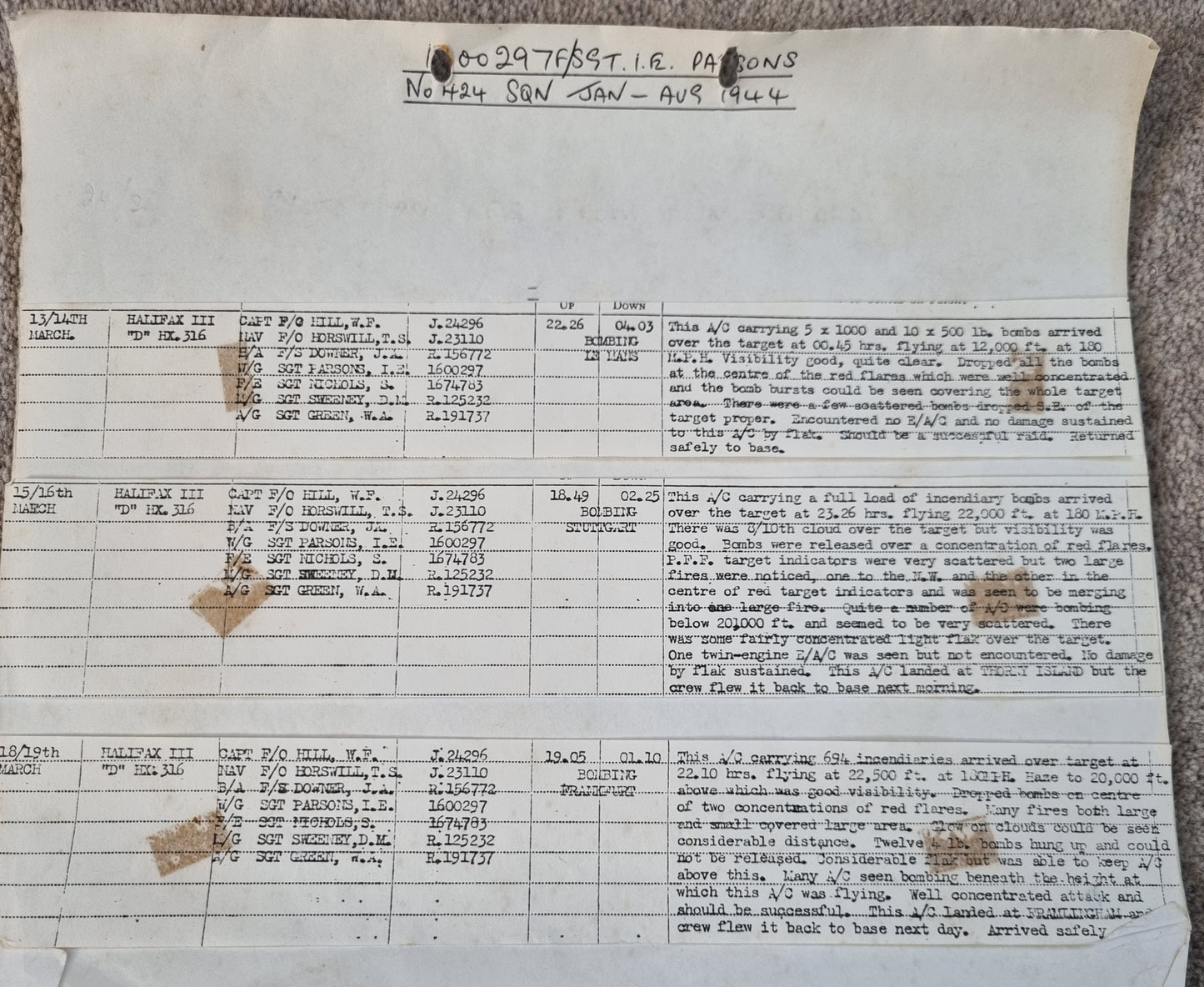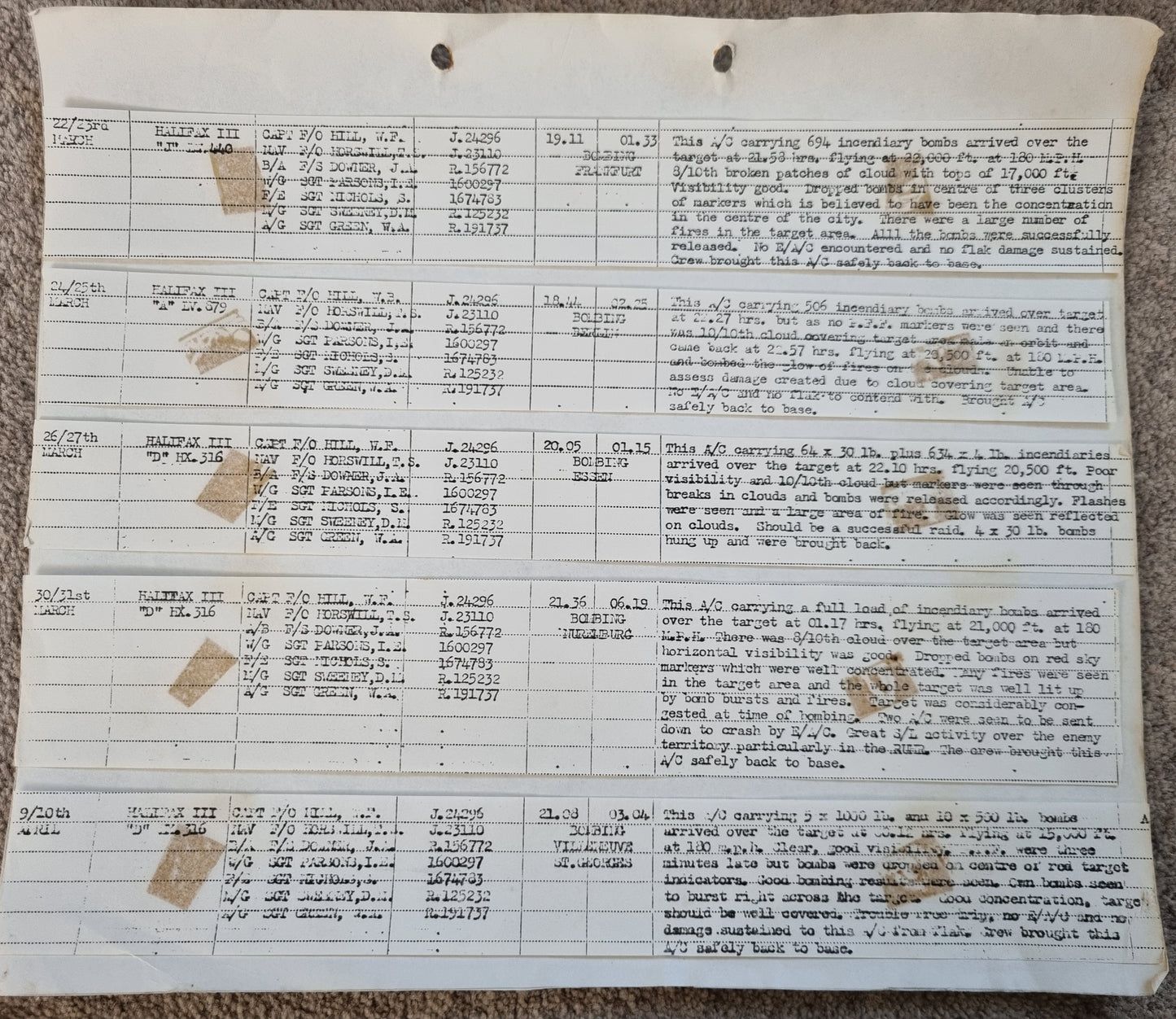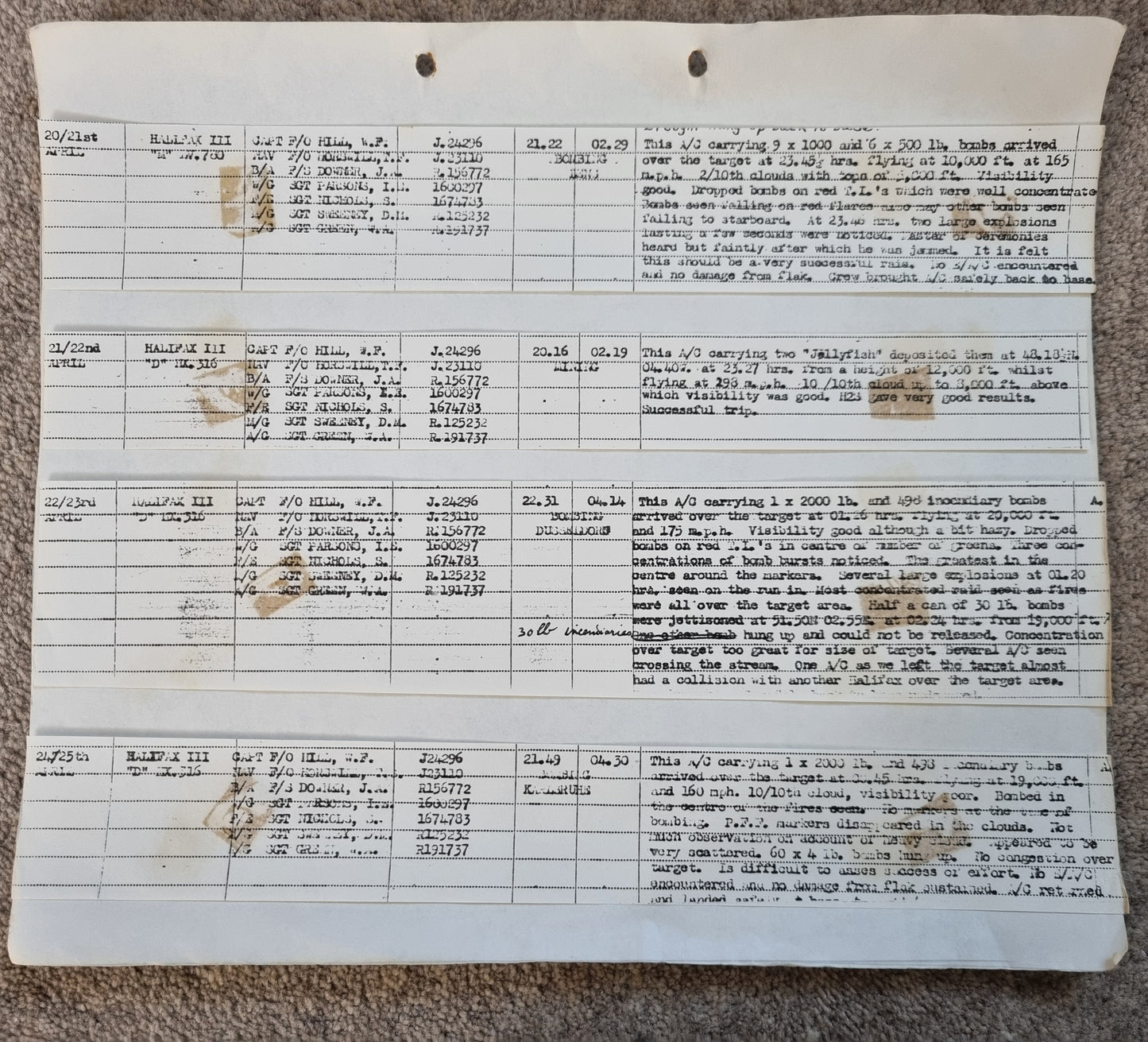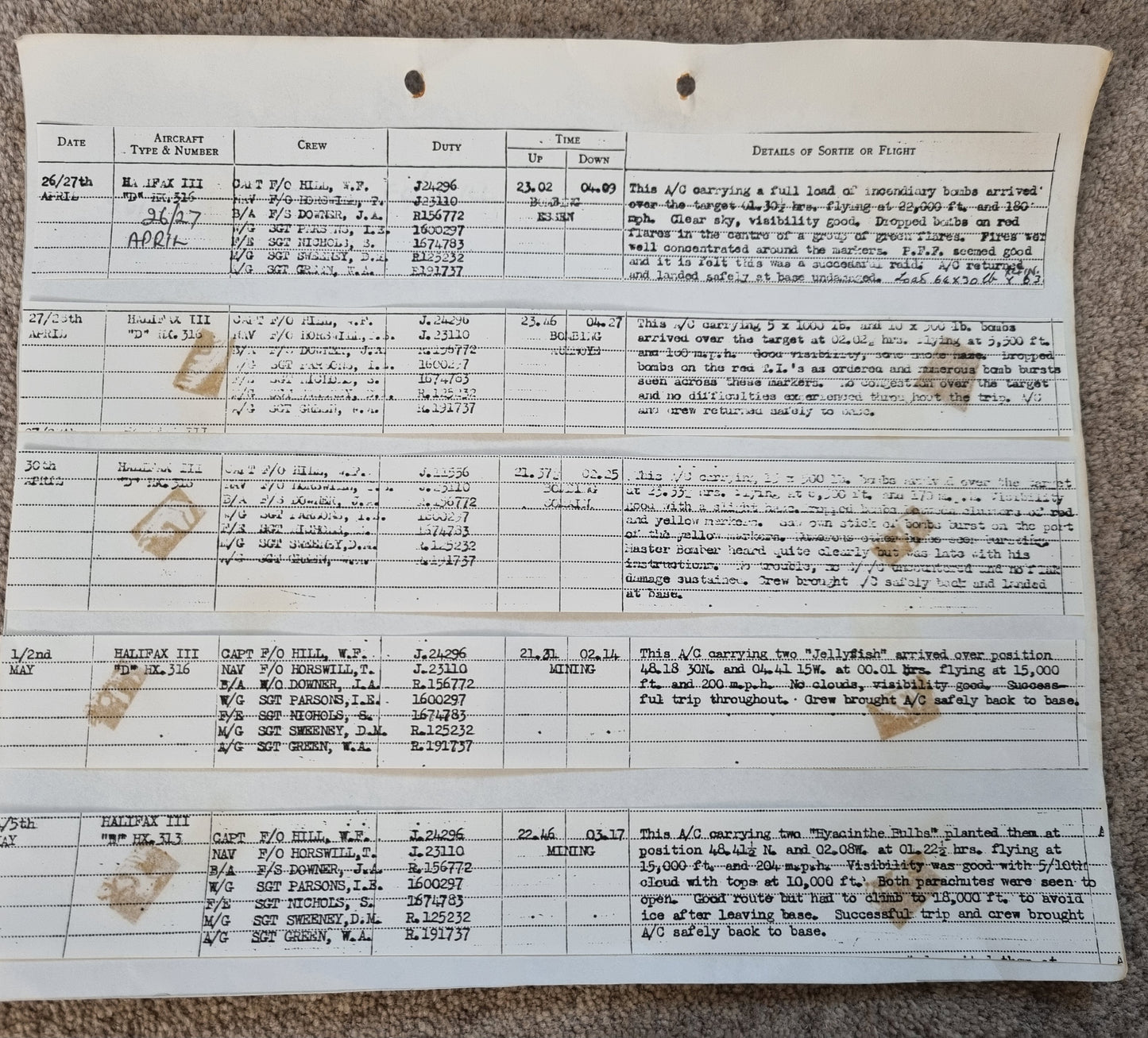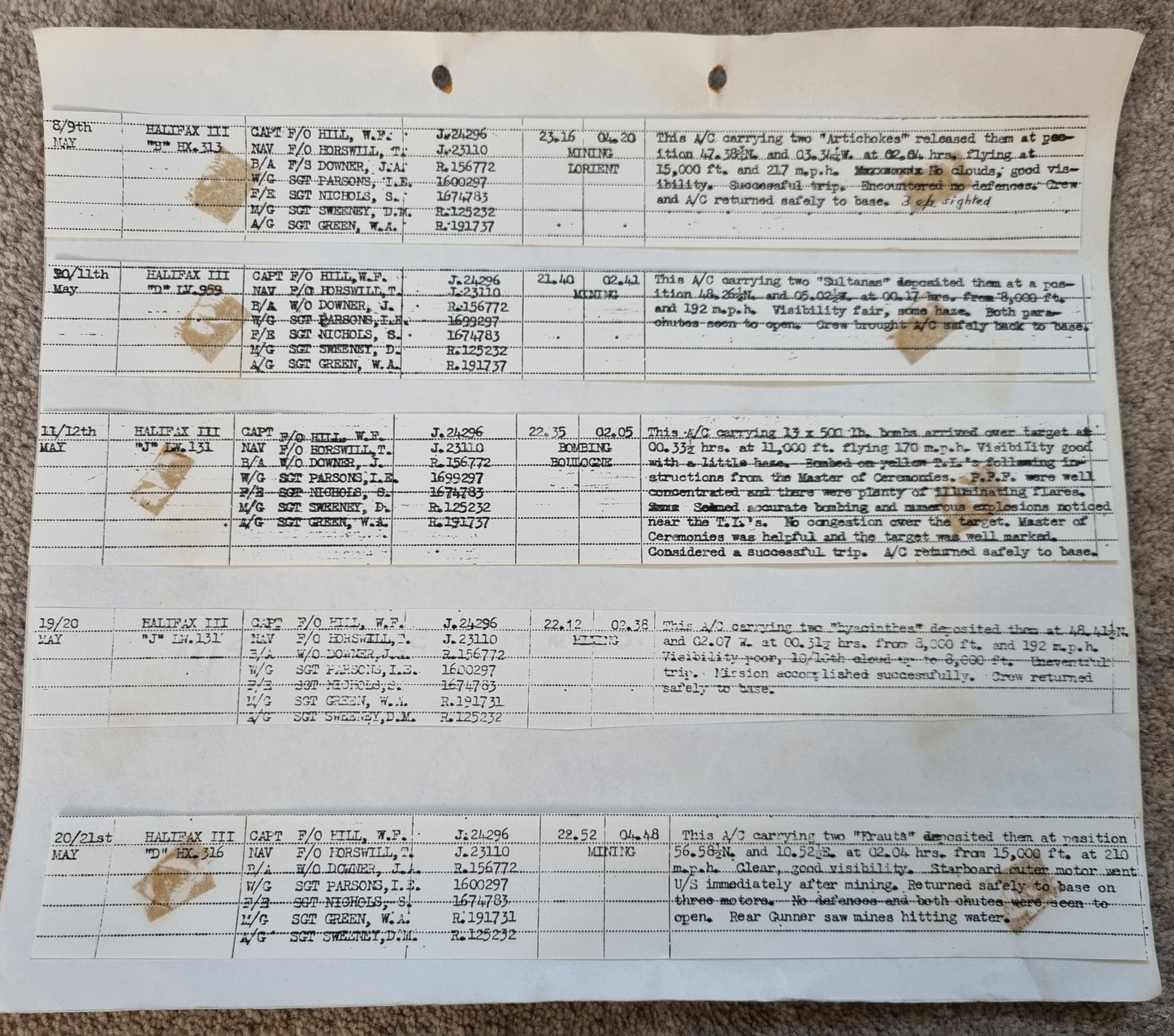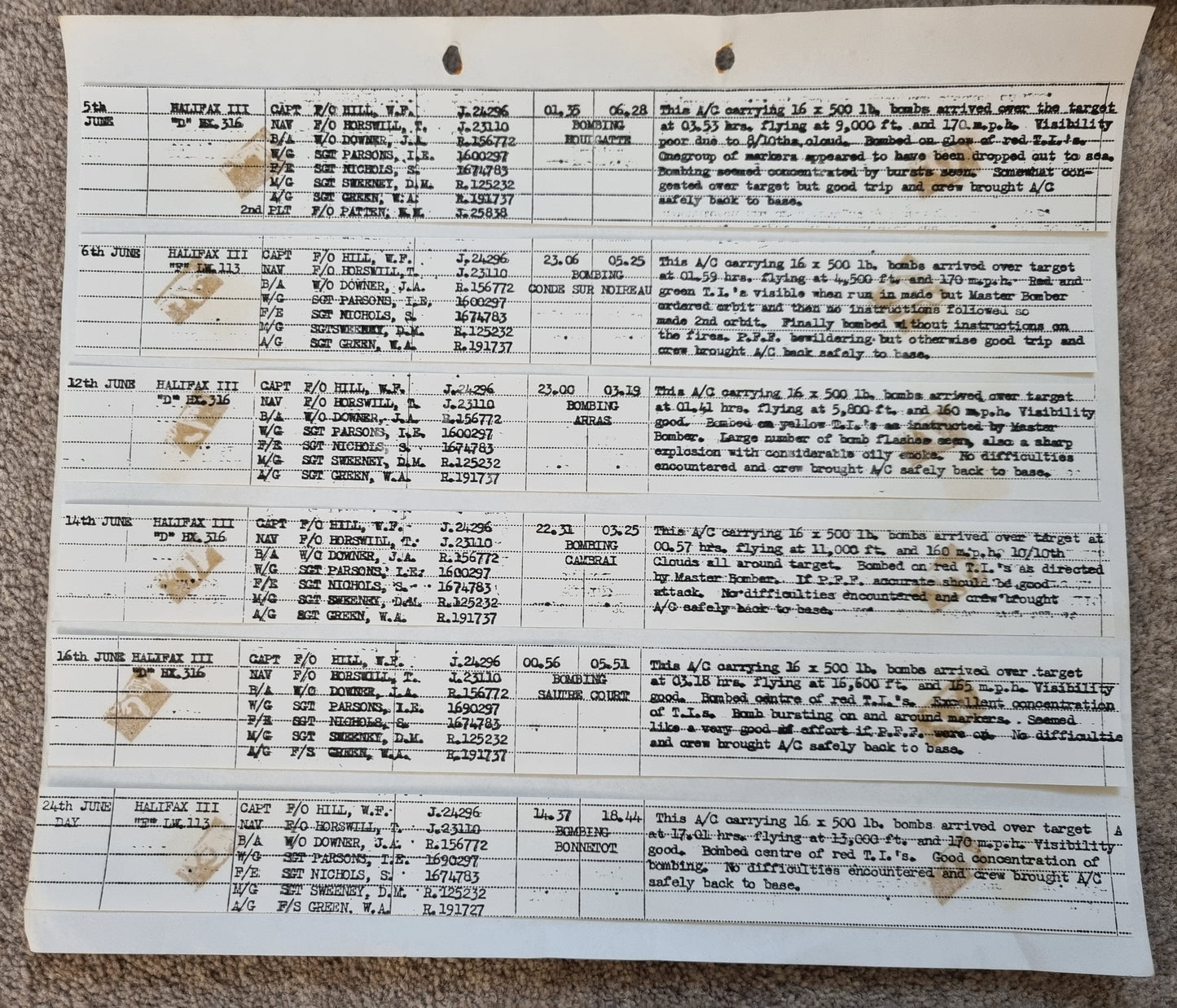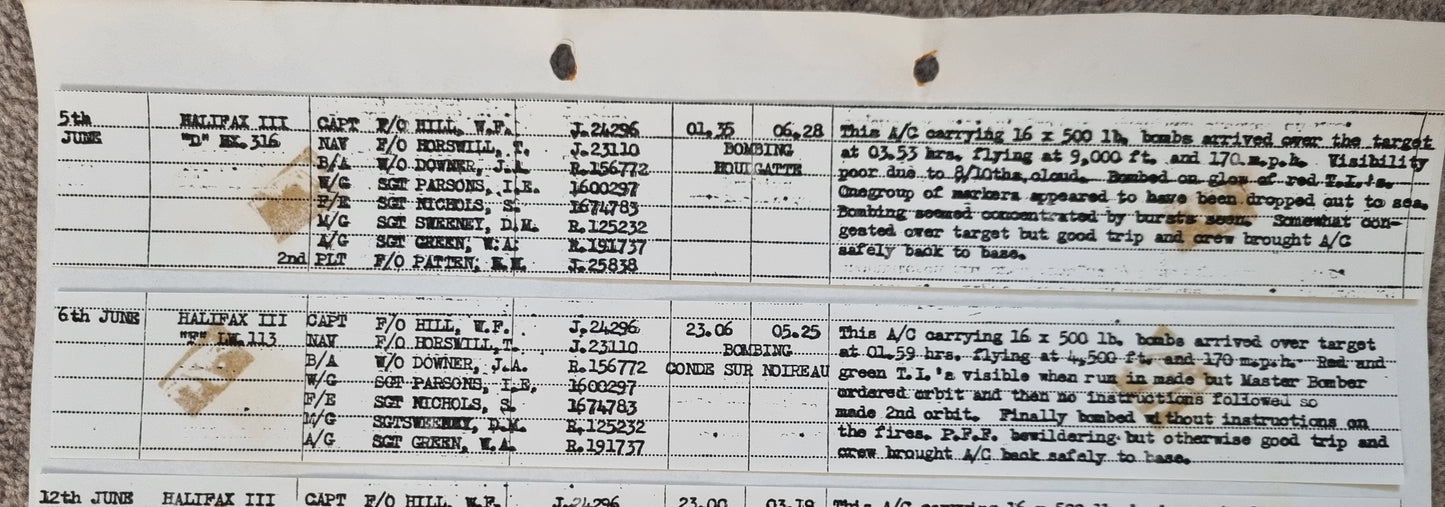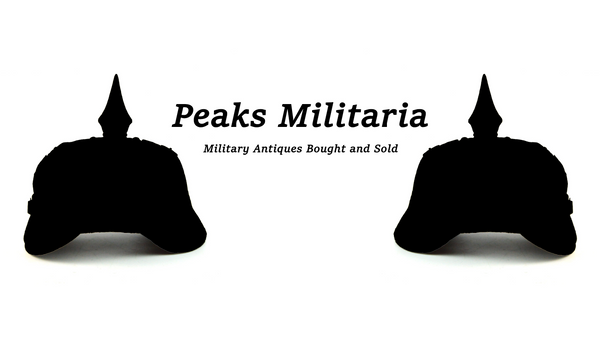WW2 RAF Flying Log Book to Air Gunner I. E. Parsons with 37 Bombing Operations including DDAY with Combat Reports
WW2 RAF Flying Log Book to Air Gunner I. E. Parsons with 37 Bombing Operations including DDAY with Combat Reports
Couldn't load pickup availability
Fantastic Original WW2 RAF / RCAF Flying Log Book for Flight Sgt Ivan Edwin Parsons (1600297, 182675) – an Air Gunner / Wireless Operator flying in Bombers and including an operation on DDAY, and 36 missions overall.
Also Includes original typed versions of the 424 (RCAF) Squadron Air Operations Record Book reports for the period March 1944 – August 1944 for each of his bombing missions, marked SECRET.
The logbook covers the period April 1943 - July 1945 It includes just over 217 hours of day flying and 265 hours of night flying.
Aircraft flown include Halifax, Oxford, Mosquito and Sunderlands
He took part in operational missions over Germany, France and then based in India.
He was part of RCAF 424 Squadron based at Skipton-on-Swale for most of his European ops.
The early part of the book from April 1943 covers his training at
- No.2 Wireless School at Madley (Apr 43 - July43)
- No. 9 Observer Advance Flying Unit at Llandwrogin Wales (July 43)
- Operational Training Unit at RAF Pershore where he was on Wellington bombers (Aug 43 -Oct 43)
- No. 1664 Heavy Conversion Unit at RAF Dishforth(Dec 43 – Jan 44)
Following the completion of his training in January 1944 he joined RCAF 424 Squadron at Skipton-on-Swale in Yorkshire and then taking part In his first operational mission on 24th Feb 1944 over Schweinfurtin Germany.
Bombing targets listed are, amongst others, Caen, Schweinfurt,Le Mans, Stuttgart, Frankfurt, Berlin, Essen, Nuremberg, Paris, Lens, Crest,Dusseldorf, Karlsruhe, St Malo, Lorient, Arras, Cambrai, Metz, Hamburg.
The Caen raid is notable for taking place on DDay, and is followed by a raid later the same day on Conde-sur-Noireau just south of Caen.
There are other entries for the Battle of Normandy including Villers Bocage.
Overall 36 operational / bombing missions are listed as taking place between February and August 1944, which must have taken a huge toll.
The 8 pages of Air Operations Record Book reports are fascinating and include the names of all the Halifax III crews that Parsons flew with.
They include a number of 'Mining' missions where the RCAF were seeding marine mines off the French coast, mainly around the vicinity of the German submarine pens at Lorient and Brest.
These contain code words for the locations - these are :
- Jellyfish = Brest
- Hyacinth = St Malo
- Artichokes = Lorient
- Sultana = Ushant Island
After operations in Europe he was posted to India from December 1944, based at No. 1672 M.C.U at Yelahanka near Bengalaru in southern India, flying in Sunderlands, Oxfords and Mosquitos.
Also supplied are photo copied versions of the Air Operations Record Book reports and of the contents of the log book.
Some excerpts from the Operations reports are
|
Date |
Aircraft |
Pilot |
Place |
Duty |
|
15-16/3/44 |
Halifax III HX316 |
F/O W F HILL |
Stuttgart |
This a/c carrying a full load of incendiary bombs arrived over the target at 23.26 hours flying 22,00 ft at 180 mph. There was 8/10th cloud cover over the target but visibility was good. Bombs released over a concentration of red flares. P.F.F. target indicators were very scattered but two large fires were noticed, one to the NW and the other in the centre of the red target indicators and was seen merging into one large fire. Quite a number of A/C were bombing below 20,100 ft and seemed to be very scattered. There was some fairly concentrated light flak over the target. One twin engine E/A/C was seen but not encountered. No damage by flak sustained. This A/C landed at Thorney Island but the crew flew it back to base the next morning. |
|
22-23/4/44 |
Halifax III HX316 |
F/O W F HILL |
Dusseldorf |
This A/C carrying 1 x 2000lb and 490 incendiary bombs arrived over the target at 01.26 hours flying at 20,000 ft and 175 mph. Visibility good although a bit hazy. Dropped bombs on red TIs in centre on number of greens. Three concentrations of bomb bursts noticed. The greatest in the centre around the markers. Several large explosions at 01.20 hrs seen on the run in. Most concentrated raid seen as fires were all over the target area. Half a can of 30lb bombs were jettisoned at 51.50N 02.55E at 02.24 hrs from 19,000 ft. 30lb incendiaries hung up and could not be released. Concentration over target too great for size of target. Several A/C seen crossing the streams. One A/C as we left the target almost had a collision with another Halifax over the target area. |
|
5/6/44 |
Halifax III HX316 |
F/O W F HILL |
Hougatte (nr Caen) |
This A/C carrying 16 x 500lb bombs arrived over target at 03.53 hrs flying at 9,000 ft and 170 mph. Visibility poor de to 8/10ths cloud. Bombe on glow of red T.I.s. One group of markers appeared to have dropped out to sea. Bombing seem concentrated by bursts seen. Somewhat congested over target but good trip and crew brought A/C safely back to base. |
|
6/6/44 |
Halifax III LW113 |
F/O W F HILL |
Conde Sur Noireau |
This A/C carrying 16 x 500lb bombs arrived over target at 01.59 hrs flying at 4,500 ft and 170 mph. Red and green T.I.'s visible when run in made but Master Bomber ordered orbit and then no instructions followed so made 2nd orbit. Finally bombed with instructions on the fires. P.F.F. bewildering but otherwise good trip and crew brought A/C safely back to base. |
|
8/7/44 |
Halifax III LV998 |
F/O W F HILL |
Mining |
This A/C carrying three "artichokes" deposited them in the garden area at 01.30 hrs from 10,000 ft flying at 200 mph. Moon clear, visibility good. No difficulties encountered and crew brought A/C safely back to base. |
RCAF 424 Squadron – the “Tiger Squadron”
The 424 Squadron, known as the "Tiger Squadron," was a Royal Canadian Air Force unit that played a significant role in World War II, primarily in bombing operations over Europe, earning 14 battle honours overall.
No. 424 Squadron was adopted by the City of Hamilton, Ontario, so they designed their squadron crest with a tiger's head in reference to the rugby team, the Hamilton Wildcats. Under the tiger, the motto reads"Castigandos castigamus," or "We chastise those who deserve to be chastised."
Based at Topcliffe, "Tiger" Squadron was formed on 15th October, 1942.
Originally part of No. 4 Group, 424 Squadron joined No.6 (R.C.A.F.) Group in January of 1943. A few months later the unit was transferred to Leeming, and then Dalton for a brief time. From Dalton the squadron moved to Beaufarik in North Africa from May to October in 1943 to attack targets in Sicily and Italy.
Over the summer, 424 Squadron was also stationed at Kairouan/Zina and Hani East L.G. before returning to Britain.
On their return to the United Kingdom, 424 Squadron was stationed at Skipton-on-Swale and remained there for the rest of the war.
Initially, the Wellington was the aircraft operated by the squadron. Bombers marked with "QB" were with 424 Squadron. It wasn'tuntil 1943 when the unit returned from North Africa that they converted to Halifax bombers. For the last three months of operations, the Lancaster was used.
Share
